Maja Voje's Blog
November 21, 2025
Forget Funnels: Your Next GTM Engine Is Prompt-Led
Dear GTM Strategist,
Over the last year, I’ve seen a strange paradox inside GTM teams.
Everyone is “using AI” – but few are actually winning with it.
We copy prompts. We experiment. We wire tools together.
And still, 95% of AI pilots never make it to production. The GenAI Divide is getting wider – fast.
That’s why I invited Matteo Tittarelli, GTM consultant at Genesys Growth and Co-founder of GTM Engineer School, to write this week’s guest post.
In this post, he breaks down how top GTM operators move from prompt chaos to Prompt-Led Engines – with real-world examples from teams like GrowthX and Gorgias, and a framework you can actually apply today.
You will learn:
The 4 levels of prompt maturity
The P.R.O.M.P.T. framework for turning ideas into reusable assets
How to scale an agency or automate enterprise customer support with the Prompt-Led Engine
If you feel you’re sitting on AI potential you’re not fully capturing yet, this one is for you.
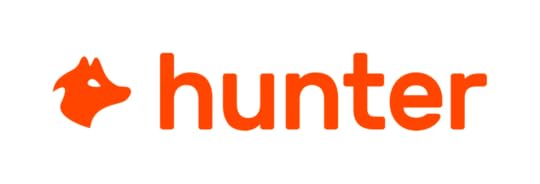
If you are new to all this outbound, GTM engineering and prompting craft that looks a bit like a programming language or rocket science - worry not :)
Don’t be absorbed by FOMO, we all have to start somewhere - and one of the best, most accessible ways to get your outbound GTM motion up and running quickly and affordably is Hunter.
Hunter was the first “find emails” software that I’ve ever used back in 2017 - and now, in 2025, they’ve evolved to add intent data, verifying emails, sending email sequences to leads, all in one platform. Today, I am proud that they are supporting the GTM Strategist mission.
Here is a 5-minute demo of how I found FREE contacts by prompting Hunter.
“Find me companies that are just like Clay and recently got funding” - that’s it. I could identify three amazing opportunities immediately.
The easiest way to win new business? Do your job really well, produce a strong case study, and pitch it to lookalike companies who need the same results that you already know how to deliver.
Don’t wait for decision makers to magically find your website.
Take control and reach out proactively.
Send a meaningful DM on LinkedIn or email and kickstart the conversation NOW - while they’re finalising Q1 plans. Get verified contacts with Hunter and tell them how you can help.
(free version available, start package $49/month)
Now, let’s hear it from Matteo. 👇
The Gen AI DivideThe age of AI is no longer emerging — it is dominantly. Upon. Us.
As of late 2025, a staggering 88% of organizations mentioned they use AI in at least one business function. In marketing and sales, this has led to a widespread tactical use of LLMs for everything from summarizing meetings with Granola to generating ad copy with Claude, to full-blown workflows of intent-based outbound across Clay and Smartlead, or AI content generation with n8n, AirOps, and Webflow.
But here’s the paradox nobody is talking about. While everyone is using AI — or trying to — it’s very few who are really succeeding with it.
We’re in a state of “prompt anarchy” — a tactical free-for-all grab of prompt templates, libraries, and masterclasses (even we have some!) free that’s seemingly creating value, but can also be so overwhelming that is creating some analysis paralysis.
This AI and prompting craze is the reason why we’re witnessing a massive “GenAI Divide”. On one hand, they say it’s spreading brain rot making content marketers and operators lazier. On the other hand, it’s skewing the real GTM alpha on the teams with the larger, most structured data sets — and the ambition to mine them.
The proof is in the numbers. A recent MIT report found that a shocking 95% of generative AI pilots at enterprise companies are failing to make it to production. This represents a massive waste of resources and a catastrophic failure to capture AI value.
This is compounded by two other critical business risks:
The infrastructure gap: While 77% of executives feel urgent pressure to adopt AI, only 25% believe their IT infrastructure is actually ready for enterprise-wide scaling. It’s like trying to run a Tesla on a lawnmower engine. This shows not just that we’re still early, but that to look at real innovation in AI usage, we’re better off turning to the smaller, more nimble players that are building these AI workflows software — that’s where the true AI alpha lies. More on this below.
The prompt management gap: Alex Halliday, founder of AirOps, mentioned: “Your prompts are your IP — keep them optimized and manageable like an engineer would”. But instead, most GTM teams treat prompts like disposable scripts instead of strategic assets. This leads to inconsistent quality and zero reusability — a far cry from the industry benchmark of 40-60% prompt reuse that high-performing teams achieve.
So, in an environment where 95% of initiatives fail, how can GTM leaders cross the GenAI Divide and join the top 10% mining the real GTM Alpha? How do you transform scattered, failing pilots into a cohesive, strategic, and scalable growth engine that drives measurable business results?
There’s no one-size-fits-all solution. BUT, we believe it starts with managing your prompts better — like they were actual IP to nurture, polish, and constantly refine.
And doing so in a system fashion — with what we call a Prompt-Led Engine (PLE).
This requires treating prompts with the same rigor as other critical GTM assets like ad campaigns or sales playbooks. It’s what we see top operators doing at the GTM Engineer School, where students from the likes of Ahrefs, Google, Slack, and more learn how to build automated systems across AI GTM like Clay, n8n, Cargo, Octave, and AirOps to automate 10-hour manual processes and reduce manual effort by 80%.
In this post, we’ll walk you through our systematic approach to designing, testing, managing, and deploying prompts as core components of your automated GTM strategy.
And we’ll give you examples of who’s doing it very well, so you know who to look up to for what good looks like!
Let’s dive in.
1. The 100x value multiplier of a Prompt-Led EngineThe journey from prompt anarchy to a Prompt-Led Engine isn’t just about getting organized — it’s about unlocking exponential value.
It’s a strategic shift from treating prompts as disposable commands to architecting them as durable, scalable assets.
As Brendan Short of The Signal notes, the future of GTM tech is about selling automated labor, not just software”. According to Brendan,
“The GTM company that will break out beyond a $1B valuation (and into $100B territory) will be the one that builds something that looks like labor in the form of swiping a credit card (instead of sourcing+ramping+managing people, equipped with software).”
However, as we’ve learned in our careers, you can’t “boil the ocean in one pot” — you have to think in phases, in maturity levels like Crawl, Walk, Run. This is how you build that future, one level of maturity at a time.
And here’s how you can apply this thinking to your prompt-led engine.
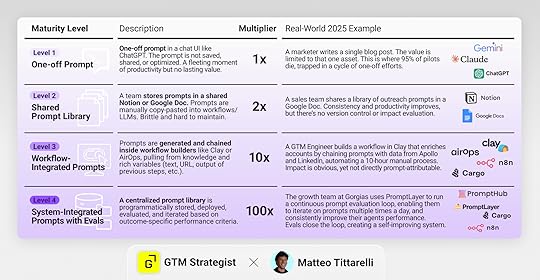 Level 1: The Individual Prompt
Level 1: The Individual PromptAn operator uses a one-off prompt to trigger a task in a chat UI like ChatGPT or Claude. Nothing new here.
Example: A marketer uses a prompt to write a single blog post. The value is limited to that one asset. This is where 95% of AI pilots die, trapped in a cycle of one-off efforts.
You might use a specific prompt generator to structure your prompt but the prompt is not saved, shared, or optimized. It’s a dead end, offering a fleeting moment of productivity but no lasting value.
Level 2: Shared, Manual Prompt LibraryA series of prompts is standardized and shared in a central prompt library repository like a shared Notion or Google Doc. Prompts are manually copy-pasted into workflows, or shared within GPT team-shared conversations. Or you might pull your prompts from your Raycast snippets as a shortcut to save time instead of manually copy-pasting.

Example: A sales team shares a library of outreach prompts in a Google Doc. Consistency and productivity improves, but there’s no version control or outcome impact evaluation.
It’s already a step up from level 1, but still brittle and super hard to maintain. If something changes, then it’s hard to trickle down the change across the team, and consistency shakes. This is where the most “AI-native” teams probably are these days — only to find out that native is just relative to who you’re comparing yourself to.
Level 3: Workflow-Integrated PromptsThe prompt is generated and embedded into an automated workflow like Clay, n8n, Cargo, or AirOps with in-line prompt generators and in-app copilots that help you refine each prompt in natural language.
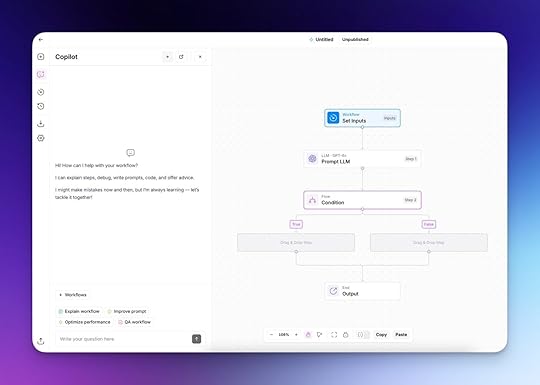
Example: A GTM Engineer builds a workflow in Clay that enriches accounts by chaining prompts with data from Apollo, LinkedIn, websites, and other data sources — automating a 10-hour manual process.
This is a significant productivity step compared to level 2 — prompts pull from proprietary data like knowledge bases, website scrapes, images, rich outputs from previous workflows’ steps and triggered by manual or scheduled events. They operate as a core processing variable of the GTM workflows, becoming a more autonomous engine for growth.
Level 4: System-Integrated Prompts with Continuous EvalsImpact on the bottom line becomes obvious and more consistent, yet not directly prompt-attributable, or iterable.
A dynamic prompt library is programmatically created and stored in a central playground like PromptLayer, where each prompt is iterated with version-controlling, deployed in your codebase or in your other tools via API, and pre-emptively evaluated based on specific performance criteria that you set based on a set of guidelines — think writing guidelines, persona criteria, etc.
Example: The Gorgias growth team uses PromptLayer to run a continuous prompt evaluation loop on their support agent, enabling them to iterate on prompts several times a day, and consistently improve their agents’ performance.
Evals close the loop, creating a self-improving system.
This 4-level model shows that the true value — and the path to crossing the GenAI Divide — is not in individual execution, but in systematic integration. It’s the difference between being an AI-Not and an AI-Native, as Brendan Short would say.
2. P.R.O.M.P.T: a Framework for Building your Prompt-Led EngineWhy does a framework like the one below work when 95% of AI pilots fail? Because it transforms prompting from a creative art into a more rigorous, technical discipline that can be iterated on. Frameworks force you to move from asking “What can this prompt do for me right now?” to “What system can this prompt power for the business tomorrow?”.
It’s a repeatable process for turning ideas into great assets — aligning multiple assets together to form a compounding growth engine.
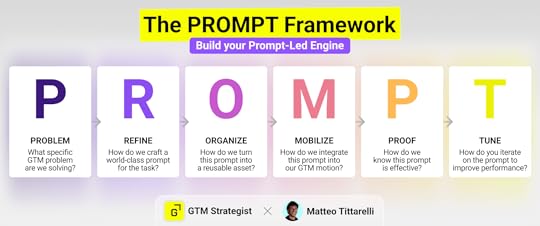 P — Problem
P — ProblemBefore writing a single line of a prompt, you must first articulate the specific GTM problem you are trying to solve. This critical first step forces you to move beyond vague tasks and define a clear business objective with measurable success criteria. Is this a revenue-critical prompt for personalizing outreach, or a strategic one for running complex competitor research?
Tools like WhisprFlow can be invaluable here, allowing you to capture unstructured voice notes — minus all the uhms, ahems, and other filler words! — to brainstorm and refine them into a clear, documented problem statement, which will be the raw context for your prompt.
Just keep the `fn` key pressed and show it record your voice directly into your prompt generator.
R — RefineOnce the problem is defined, the next step is to craft a world-class prompt. This is not just about writing a question or specifying a task; it’s about comprehensive briefing and expectations settings.
Because this is where most of the market on prompt engineering is exploding, we won’t spend much time discussing the best prompt engineering frameworks like COSTAR or SPICE. Instead, we’ll report relevant, condensed takeaways from one of the best 2025 prompt engineering deep dives out there — from the one and only Lenny’s Newsletter.
Few-shot prompting — providing examples into the prompt — can dramatically improve accuracy by showing the model what good looks like, often boosting performance from 0% to 90%. Adding sections in your prompts like or with each section of the expected outputs sets the right expectations with the AI.
Context is underrated and massively impactful when relevant background information is included in the right format and order. This is one of our favorites, especially when we need to ground the LLM in structured, deep knowledge of product, ICP, and competitors.
To generate context, you inject websites that the LLM can scrape. But the more structured and richer the context, the better the output.
If you want to take it up a notch — especially if you have a complex product or technical ICP to ground the LLM into — you can create a messaging and positioning library in the likes of Octave, export it as markdown, and re-import it in your LLM of choice as knowledge. This does wonders in grounding LLMs in useful knowledge and avoiding hallucinations.
Advanced techniques like decomposition and self-criticism unlock better performance by breaking problems into sub-problems or having models critique their own outputs. Especially good in prompt chains like fact-checking or aligning for specific writing guidelines or personas.
In this step, you can leverage Custom GPTs or a platform like PromptHub to build your prompts — and have them pull from brand kits and knowledge bases, turning a simple instruction into a more context-rich directive.
O — Organize
No matter how rich the structure of your prompts, or how much context you give them — if you use it once, it is a missed opportunity for repeated usage and improvements. To scale your PLE, you must turn prompts into reusable assets. This means storing them in a centralized repository like PromptLayer, Langfuse, or PromptHub.
This is your “GitHub for Prompts.” Here, you can visualize and manipulate your prompts and:
Apply version control (e.g., v1.2.3) to track changes in your prompts done by your teams and compare differences between versions.
Test prompts across different LLM models — OpenAI, Anthropic, Llama, etc. — to find the best fit for the task, as well as adapt prompts to any LLM model.
Create modular snippets variables tables like {company context}, {industry}, {persona}, {goal}, {format}, etc. to flexibly feed into your prompts and adapt your output to various use cases.
Organize prompts into folders and labels by GTM channel (e.g., “SEO,” “Outbound,” “Social”) or workstream.
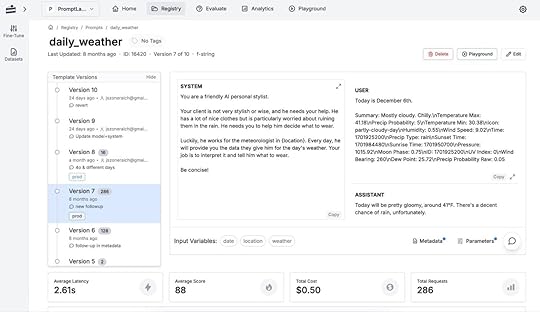
M — Mobilize
This is where your prompts are deployed in your GTM workflows and become an active part of your GTM engine. This can be done via native HTTP API calls in tools like n8n, Clay, or Cargo, or via webhooks in tools like AirOps.
This allows you to call your prompts at scale as part of your chained workflow sequences, mobilizing your library of assets as a cohesive, automated workforce. You can also optimize model selection — Claude, GPT, Llama, Perplexity, etc. — based on pre-emptive testing.
P — Proof
An engine is useless if you can’t measure its output. In your prompt repo, you can track performance at two levels. First:
Prompt-level KPIs like accuracy, latency, credit consumption, and reuse rate.
Portfolio-level business metrics like the lift in conversion rates, reduction in CAC, or direct impact on revenue.
Tools like PromptLayer, Langfuse, and PromptHub can provide some of the more basic analytics out-of-the-box, while the observability needed to connect prompt performance to tangible business outcomes might require some more custom
T — Tune
The final step is to close the loop. Based on the performance data you’ve gathered, you can now systematically improve your prompts. This involves running A/B tests on different prompt variations, using a mix of Human Evaluation (e.g., paired comparisons) and Automated Metrics (e.g., cosine similarity).
For scalable feedback, you can even use the LLM-as-Judge technique, where another language model grades the output of your prompt. This continuous tuning process, managed within platforms like PromptLayer, is what turns a static library into a self-improving engine.
3. Prompt-Led Engine in Action: 2025 Real-World ExamplesTheory is great, but execution is everything. Here are two real-world playbooks that show how the P.R.O.M.P.T. system works in practice, from scaling an AI-native agency to automating enterprise customer support.
Example 1: GrowthX.ai — the AI-native agency engineWhat if you could deliver high-end GTM services with lower costs and healthier margins than a SaaS company? That’s the question Marcel Santilli and GrowthX AI answered by building their entire business on a foundation of AI and system-integrated prompts.
Their core problem was a classic service agency challenge: how to scale expert-led content and GTM strategy for demanding clients like Webflow and Ramp without linearly scaling headcount and trading off margins.
Instead of hiring an army of consultants, Marcel and his team built a proprietary “Content OS” — a system of work where expert strategists guide and refine AI-powered workflows. This was never just about scaling content production, but about architecting the first delivery model where every client workflow is a versioned, managed asset. The service is packaged as “AI Service-as-Software,” deeply integrating prompts into the core business logic.
The results, tracked on a real-time dashboard by Marcel are staggering: a $13.1M run rate, 151% NRR, and 70%+ gross margins. GrowthX AI proves that a Prompt-Led Growth engine isn’t just a productivity hack; it’s the new frontier of expert-led, AI-powered service businesses that are both efficient, scalable, and high-quality.
 Example 2 — The Enterprise Support Automation Engine
Example 2 — The Enterprise Support Automation EngineFor a company like Gorgias, the conversational AI serving 16,000 Shopify merchants, the GTM problem was clear: how to automate a significant portion of their GTM workflows (spoiler — not just outbound!) without adding more headcount or missing on personalization potential.
When I asked Max, who leads the Growth team at Gorgias, his answer was simple — “a relentless focus on GTM Engineering”. Their process is a masterclass in the P.R.O.M.P.T. system — running a tight feedback loop between multiple input sources, Cargo as a workflow builder, and PromptLayer as a prompt repo and agent builder.

For example, some of their workflows they shared include:
1) Automating CX feedback based on customer reviews.First, they scrape Trustpilot reviews as input.
Then, a Cargo workflow sends reviews to PromptLayer.
PromptLayer triggers multiple chained prompts that respectively
Analyze and categorize feedback by sentiment
Prioritize top feedback for each CX category
Generate CX recommendations based on detected issues and ties them to Gorgias product features.
Data is sent back to BigQuery for storage and further analysis.
Upon manual activation, some CX feedback is pushed to Webflow to create or edit landing pages.
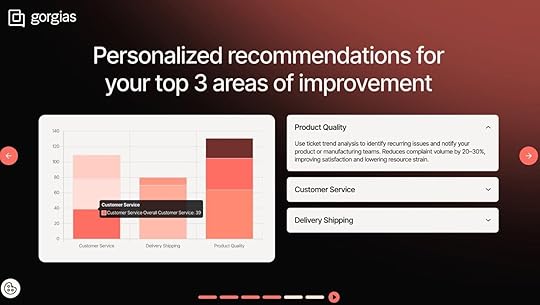 2) Scaling personalized resurrection campaigns
2) Scaling personalized resurrection campaignsFirst, the team aggregates Gong calls, transcripts and context from email threads, events attended, website visits, and email replies into a table to feed to the agents.
Then, a PromptLayer agent is triggered to create a structured summary with contextual insights, including things like:
Pain points and challenges
Goals for the upcoming year
Gorgias aha moment
Value prop pitched by the AE
Reason for closed-lost
Another PromptLayer agent pulls relevant product to craft relevant messaging
First, it extracts relevant product updates since last interaction
Then, it crafts personalized resurrection messaging including recent product updates
Then, the messages are pushed to an Instantly campaign and sent to the prospect
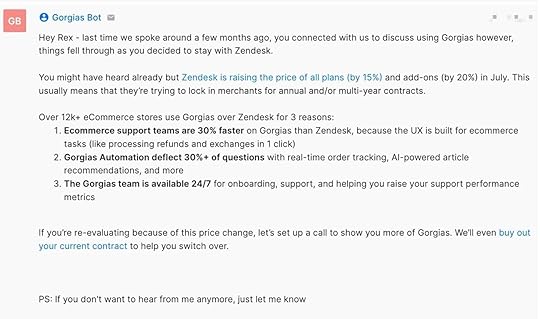 3) Automating events follow ups
3) Automating events follow upsFirst, an agent extracts events details and engagement history from Salesforce.
Then, a PromptLayer agent is triggered to enrich context data with
structured recommendations
Compare company’s competitors with app partners they haven’t integrated yet
Identify colleagues who’ve previously engaged with Gorgias
Based on the context, another agent writes an email sequence in Promptlayer
Another Promptlayer agent pulls relevant product to craft relevant messaging
Then, a Slack notification is triggered for the Partner Manager to review the message and act accordingly.
Prompts are stored and version-controlled in PromptLayer, enabling a 10-person team to make over 1,000 iterations and create 221 datasets in just 5 months. In these workflows, the Gorgias growth team runs evaluations with LLM-as-a-Judge, and performs backtesting to prevent regressions. This allows them to iterate on prompts “10s of times every single day.”
This was achieved by making prompt engineering a systematic, measurable, and scalable process. And it shows that prompt engineering and evals are still very niche and technical use case that are more common in engineering teams, but it also has GTM (engineering) applications and it has potential to become a source of real operational GTM alpha.
Your next GTM Engine is Prompt-LedThe GenAI Divide is real — and it’s widening. While 95% of companies remain stuck in Level 1 prompt anarchy, the top growth operators are building durable, compounding advantages with systematic, Prompt-Led Engines.
As we’ve seen from the examples from GrowthX and Gorgias, the difference isn’t about having more people — or better prompts! — it’s about having a system where prompts are observed, evaluated, and refined as strategic IP assets.
Crossing the divide from the 95% to the top 5% doesn’t require you to boil the ocean. It starts with a single, deliberate step. Your task for next week is simple:
Assess your maturity: Where does your team really sit on the 4-level model? Be honest.
Pick one problem: Identify one high-impact, repetitive GTM task that’s still being done manually.
Apply the framework: Take that single problem and walk it through the P.R.O.M.P.T. system. Define the problem, refine a single prompt, and organize it in a central place.
That’s it. That’s how you lay the first brick. The journey from a 1x to a 100x engine isn’t a leap — it’s a series of deliberate, systematic steps.
Now, go build your engine.
Want to work with Matteo on AI-enabled Messaging and Positioning, Landing Pages, Launches, and Content? Book a call with him here.
Or want to learn how to build AI workflows or prompt-led engines like the one described in the article? Join Matteo at the GTM Engineer School to learn to build AI workflows with top experts from Octave, Clay, AirOps, and Cargo. Sign up for the next cohort waitlist — Matteo is planning the next cohort for February 2026 (dates TBC), and get all the latest news on the GTM Engineer School newsletter.

📘 New to GTM? Learn fundamentals. Get my best-selling GTM Strategist book that helped 9,500+ companies to go to market with confidence - frameworks and online course included.
✅ Need ready-to-use GTM assets and AI prompts? Get the 100-Step GTM Checklist with proven website templates, sales decks, landing pages, outbound sequences, LinkedIn post frameworks, email sequences, and 20+ workshops you can immediately run with your team.
🏅 Are you in charge of GTM and responsible for leading others? Grab the GTM Masterclass (6 hours of training, end-to-end GTM explained on examples, guided workshops) to get your team up and running in no time.
🤝 Want to work together? ⏩ Check out the options and let me know how we can join forces.
November 14, 2025
From Book to AI Sidekick: The Future of How We Learn

ZoomInfo kindly sponsors this newsletter.
95% of AI initiatives fail due to poor data foundations. Don’t let yours be one of them.
ZoomInfo built a 2-minute AI Readiness Assessment that shows you where your GTM team actually stands — from foundation building to AI leadership.
It’s fast. Free. Brutally honest.
My score was 79% AI Ready. Can you beat me?
Take the AI Readiness Assessment

Dear GTM Strategist!
Tomorrow (November 15th), we celebrate 2 years since the Go-to-Market Strategist book hit the virtual shelves - and the ride has been phenomenal.
 Launch event from 2 years ago
Launch event from 2 years agoLast year, I wrote an in-depth post about my book writing and publishing journey.
So I don’t want to repeat that - if you are new here, I’d definitely invite you to read that article. It is a masterclass in pre-sale to hit an instant best-seller and launch preparation - one year of my life in the “monk mode” and demand generation trenches.
GTM Strategist shares birthday month with ChatGPT. I did not think about that much back then, but now I do because in 2025 I’ve noticed a pattern that worries me, inspires me and makes me wonder what the future of content creation holds.
Andy Warhol famously said:

Now I think that people no longer read - they just ask AI.
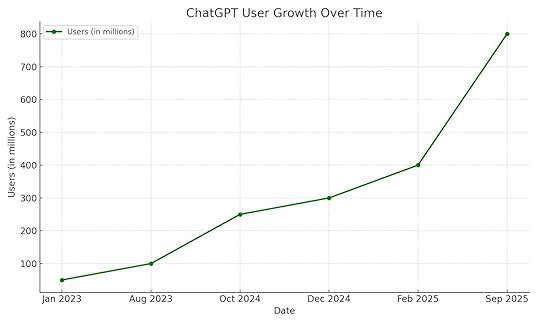 ChatGPT had 800 million weekly active users in September 2025 (source)
ChatGPT had 800 million weekly active users in September 2025 (source)And I am the last person to judge here. I use my GPTs for everything - cooking, gardening, reading whitepapers, plotting my new products. It has been a while since I have googled something because I no longer have the patience to absorb massive amounts of information to maybe find a good answer. I want personalised answers at my fingertips in seconds. I am also too lazy to listen to podcasts now and uninterested in doom-scrolling social media to find ideas. How I want to consume information has changed so much.
Did you see the same pattern?
Yet, I still spend one day a week creating content (Substack and LinkedIn), human-write all my comments, I will read the book my friends at Momentum have published (Ignite - featuring some of the brightest minds and peers in the the world GTM - Jacco Van Der Kooij, Kyle Norton, Brendan Short) because I know and love the team and trust it to be high-quality - but other than that and some of my favorite Substacks (Kyle, Emily…), I don’t want to consume much more information.
I’d occasionally binge some content from my PM friends Aakash, Lenny, Paweł … to get inspiration for new ventures and ideas. I actually call that vibe-learning - when I save their interesting newsletters and episodes and then dive in when I have the capacity to do it - but that is when I need to sharpen my divergent thinking muscle.
How do I learn instead?
I prefer to talk to people and my AIs and I don’t want to “absorb the information” in case I will ever need it. I like to work on my ability to retrieve trustworthy personalised answers exactly when I need them. Am I strange for feeling like this or is it a zeitgeist?
Private events, talks with other interesting minds in the tech space, doing “my own thing” and asking better questions- seriously - critical thinking is the new superpower. This is what separates mindless consumers of information from fierce learners and original thinkers.
As the world has changed, so must my product portfolio to fit the needs and preferences of modern learners. White reading is beautiful for your mind and soul, I did something that most authors are dead afraid of:
I uploaded my book from page 1 to 345 to Miro and open-sourced it as a Sidekick.
You can now chat with it and the GTM Strategist Sidekick will guide you through every stage of your go-to-market strategy. It will help you with brainstorming, summarizing ideas, and creating documents.
 GTM Strategist Sidekick
GTM Strategist SidekickWhy did I not do that with GPT and send it to you a year ago? Because, to my best liking of GPT, it still hallucinates and acts off. I wanted to have a more stable environment, direct access to the tech team if something goes off, and integrate it to work collaboration experience beyond “the answer machine”. I want it to create assets for you in the environment that we are already working in.
The other thing I did to celebrate the second anniversary of the Go-to-Strategist launch is to invite my team for a spa day - ayyy - you might not be interested in that. OK, I open-sourced my hero workshop back in May: Reverse-engineering of growth ideas based on objective back in March when I launched my GTM Blueprint in Miro, but now I empowered the experience with intelligent workflows so you will look like a superstar when you run workshops internally or externally with your peers or clients. It has such a strong wow factor.
 My most popular workshop template now includes automated flows - it turns outputs of brainstorming into comprehensive documents and timelines
My most popular workshop template now includes automated flows - it turns outputs of brainstorming into comprehensive documents and timelinesBoth are available free of charge in Miroverse:
If you want early access to Miro’s AI capabilities, join their waitlist here.
OK - now that the celebration is over 🎉 and you hopefully have the new assets opened in another tab, let me thank you SO MUCH for your support, attention and interest.
We have built a community of tens of thousands of companies and individuals that share the mindset of being Curious, Disciplined and Adaptive and therefore well prepared for the age of AI and whatever comes our way 💪- we got this!
What is next might be the next question popping up. In 2025, I’ve built 3 strong business units:
Digital products: GTM Strategist Book, GTM Strategist Checklist and GTM Strategist Masterclass
GTM Strategist Media: 25K Substack, 73K LinkedIn
Consulting boutique business where we mainly work with corporate ventures, startups and scaleups on elevating their GTM strategies
This is great for diversification as the algos keep on playing tricks on us and want moar and moar monies :))) but I do have one more final promo.
The business 2.5x-ed in 2025, which is GREAT, but I do have one final FOMO - one more hill to conquer before I can really congratulate myself on building a successful business venture.
I’ll tell what that is some other time - now it is November and mission-critical is for you to build your 2026 plans - not read another other people’s ambitions 🤠 so I do invite you to set your self an inspiring objective for 2026, invite your team to pitch in with ideas what can you guys do to make it happen, prioritize what will most likely get you there and commit to do it.
And if you need my whispers in your ear, you’ve got the GTM Strategist Sidekick that will answer your questions and commands. Yeey - now we can finally work together!
Let me know how it goes.

📘 New to GTM? Learn fundamentals. Get my best-selling GTM Strategist book that helped 9,500+ companies to go to market with confidence - frameworks and online course included.
✅ Need ready-to-use GTM assets and AI prompts? Get the 100-Step GTM Checklist with proven website templates, sales decks, landing pages, outbound sequences, LinkedIn post frameworks, email sequences, and 20+ workshops you can immediately run with your team.
🏅 Are you in charge of GTM and responsible for leading others? Grab the GTM Masterclass (6 hours of training, end-to-end GTM explained on examples, guided workshops) to get your team up and running in no time.
🤝 Want to work together? ⏩ Check out the options and let me know how we can join forces.
November 7, 2025
The LinkedIn Paradox: Why B2B’s Favorite Channel Got Harder - and How to Win Anyway
This post is kindly sponsored by Ahrefs - a leading SEO & marketing intelligence platform that helps you accelerate the growth of organic traffic to your website.

51% of GTM practitioners in the survey we did with Kyle Poyar are planning to increase their GTM investments in AI search (AEO). But how? What exactly to do?
After writing one of the most popular GTM Strategist posts this year, I invited a seasoned SEO expert Jairo Guerrero, co-founder of Organic Hackers, to do a LinkedIn Live where we will answer ALL your AEO questions.
We’ll invite some of you for a hot seat where we will turn your keywords into prompts that you want to position yourself for using Brand Radar by Ahrefs. Get more high-quality, higher-converting traffic from AI answer engines such as ChatGPT, Perplexity, and Google AI Overviews.

Dear GTM Strategist!
Last week, we discussed the results of The 2025 State of B2B GTM Report: What is working in GTM we did with Kyle Poyar. One of the key learnings that stood out to me was the high reliance on LinkedIn in B2B.
Observe this chart for a sec. 8/10 (arguably more) of planned GTM investments increase are directly or indirectly connected to LinkedIn: founder brand, outbound, influencers, ads … Different tactics, potentially the same channel.
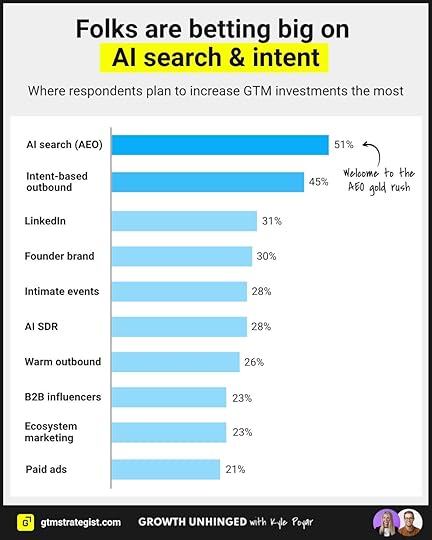
The same applies to my GTM Strategist business. 70% of our pipeline is influenced by the “stuff we do on LinkedIn.” I am strategically developing other channels because dependencies are never a good thing in business, but it appears that the world is sending us a clear message - for most B2B tech, LinkedIn is where the audience is.
But it got tougher - much tougher. 😪
In this post, I am going to share with you some of the things we are doing to “keep up” with whatever LinkedIn throws at us.
Image+text inspired by best-in-class creators - 🎁 my LinkedIn Moodboards, now AI-generated 🤖
Lead magnets - comment to get something 🧲
Employee advocacy - activation of 3-10 profiles that are orchestrated to promote the company and support each other to grow
Influencer partnerships: Working with established brands that invest in thought leadership ads
Proactive outreach, aka “social selling” that I prefer to call intent-based outreach 🙂
But first - I have come up with conspiracy theories to share. 🧟
Organic reach has been on a downward slide throughout 2025 🛝- and I think I know why …I was reviewing our data the other day and discovered that even though our audience grew by 28%, the organic reach was there-there with last year and I had to fight hard to keep it this way.
Some of my 50K-200K creator friends that we have WhatsApp mastermind groups with are convinced that the LinkedIn algorithm has shadow-banned them 👻 because they lost up to 90% of their organic reach in 2025 while their followers are still growing.
My mind works differently. I say follow the money. LinkedIn is largely doing what other platforms, such as Meta, have been doing for 5-10 years. And this was the question of time- LinkedIn now allows you to sponsor (boost) your own posts directly, not through thought leadership ads - just like good old Facebook did in 2012.
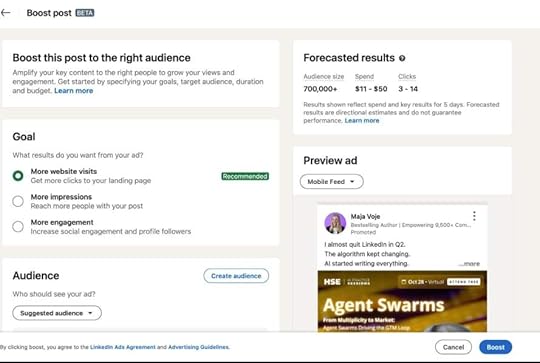
Of course, we immediately took it for a spin and between us, though leadership ads worked better than “the native boost”. So get your 2026 budgets ready because it is pay to play, baby 🎰
Before I start developing more LinkedIn conspiracy theories, such as:
Witch hunt on automations - I do not even use tools with Chrome plugins these days
Dead LinkedIn - I think 70% of engagement are AI comments now - where are the humans and
Meta LinkedIn - Ghost town of consultants trying to sell each other growth secrets how to succeed on LinkedIn like a pyramid scheme
(I believe in all three, though 🛸)...
Let’s shift our attention to what’s working and get this discussion on a more positive note.
I hate vague advice in the form of “just write better content” - sure, but how?
And some of us do not have 20h/week to spend thinking about hooks for LinkedIn posts in a local cafe - life gets busy.
AI to the rescue. What does GREAT look like in your space?
My AI-generated LinkedIn Moodboards: One size does not fit all - Gather proprietary intelligence and develop a tasteWhenever I don’t know what to do on LinkedIn, I start saving posts and taking screenshots. I used to do that manually, but by now we can create this neat-looking moodboard of best-performing posts by selected creators and their best publishing practices with our 4 LinkedIn AI agents and get the results on our Slack in minutes - not weeks.
Here is an example of one of these moodboards.
Instead of following general LinkedIn wisdom, “Take a photo with a goat 🐐 and write to the world how hard your life was because you were born in a village,” to hijack the attention of people scrolling, I want to study the creators that I actually learn something new from. I know that they are doing well in business (not just life).
They have their own best practices that have worked well for them. Imagine it in a way that every vertical has some “taste makers” that set the standard for what works well, and the standard is high. While I firmly believe that you should develop your own style, learning from best practices (not merely copying them!) from other creators in your niche is a great place to start.
Here is an example: Right now, I know that I should work on my writing skills, and I want to crack the equation of what excellent communication for AI agents looks like. I selected a couple of creators that do that well for my taste and tried to generate intelligence of what works best for them visually, topically and tactually - when to post, posting frequency, etc.
 Get the moodboard for free HERE
Get the moodboard for free HEREHere are 5 key takeaways from this analysis - concise, quantified, and relevant for GTM leaders building their LinkedIn strategy:
Visuals win.
62.7% of top-performing posts were single-image posts, while only 20.2% were carousels and 10.6% videos. Text-only posts made up just 4.6%.
Translation: prioritize clean visual formats with strong narrative hooks over pure text or video.
Consistency beats volume.
Engagement rises roughly +56 interactions per extra post per week (correlation = 0.38).
Heavy posters like Eduardo Ordax (15 posts/week) and balanced creators like Chris Donnelly (6 posts/week) both perform—frequency matters, but not at the cost of quality.
Timing creates leverage.
Posts published at 04:00 UTC drive the highest engagement, while 11:00 UTC is the most common posting time.
Engagement peaks on Thursdays (≈1,172 avg. per post) even though most creators post on Fridays.
Posting earlier and one day before the crowd captures attention.
Comments drive algorithmic lift.
Top creators generate 500+ comments/post, not just likes.
Example: Chris Donnelly’s average post hits 2,091 total engagements, including 527 comments.
For GTM teams, framing posts to spark discussion outperforms static announcements.
Original content outperforms reposts.
5 of 10 analyzed profiles didn’t repost at all, and for the others, 60–70% of engagement still came from original content.
Consistent creators win by publishing proprietary insights, frameworks, and data—not resharing others’ work.
These insights are based on the creators that I want to learn from, not some random samples or full-time creators that found their meaning in life working 5/hours a week from a tropical island 🥥 🐠🌴 .
I have nothing against people who take selfies with farm animals or indulge in life in Asia - good for them. It is not something I want to discuss publicly, and I doubt my ICP is interested in such topics, so I want to ensure that they are not included in the data sample from which I generate my intelligence.
In reality, what happens next is that I stare at their visuals for hours and try to figure out what we can learn to do better.
Want this board to get more insights?
Get it here for free: https://join.gtmstrategist.com/moodboard-fall-2025
Now that we somehow know how to create ”the base content” that will be interesting and hopefully engaging to our ICP based on taste-makers - it is time to amplify our content efforts.
Stop thinking about LinkedIn as organic Inbound GTM Motion: In 2026 - bring on all your GTM ammunition to get it flyingIn her recent article Build a LinkedIn Flywheel, not a disconnected social strategy Emily Kramer (Ex-CMO at Asana) beautifully summarized something that I have been observing too since last year - you cannot just “create content” and hope that people will magically visit your website and buy your stuff or request a meeting in DM. We have to work much harder to get a good ROI from the channel.
Emily visualized the LinkedIn Flywheel™ like this:
 Source
SourceThis is particularly beneficial for large brands with sufficient budgets and resources.
If you are bootstrapping, working as a sole GTM contributor, or just want to start light because you have to show your boss some results before they unlock resources to bring a bigger vision of what we should be doing to life, here is the list of 5 tactics that I have seen working well for my business and folks I work with:
Double down your commenting game. I try to avoid AI-generated comments, but I do spend 30 minutes a day writing comments on selected profiles’ posts. My daily target is between 10 and 20 value comments. That is a routine I hate more than workouts, but I keep on doing it because it works and it is great for my networking. Sometimes, my comments on other people’s posts receive more impressions than my native post, and I gain visibility in new audiences. Thinking got a bit easier now that I have my n8n agents bringing me relevant posts to comment on Slack, so I am no longer dumb-scrolling LinkedIn notifications and newsfeed - more info.
Kick things up with some lead magnets - “comment to get something”. My best lead magnets get 100K+ impressions and get me thousands of new followers when executed right. - here is a guide.
Employee advocacy - activation of 3-10 personal profiles that are orchestrated to promote the company and support each other to grow. Some companies that you can study that do this beautifully are Ahrefs, HubSpot and Dreamdata.
LinkedIn Ads: Our best performing format atm is though leadership ads, especially the campaign with ran with our partners who do influencer marketing. In addition to that, consider classic LinkedIn ads or ABM. You can find detailed guides for each in our archive.
Proactive outreach, aka “Social selling,” aka “Account-Based Anything” - you call it what you will, it is you or your sales team writing to folks that displayed behaviors on LinkedIn or fit your “ICP” definition. One of your favorite tools to use here is HeyReach (now approaching 10M ARR in 2 years).
🤞At least 2 of them will work so you can create your own LinkedIn Flywheel™ and start closing business again, rather than complaining that “LinkedIn is not the same as it was in 2021”.
Hopefully, this was helpful to you.
Even more: hopefully it is behavior-changing content that will yield a positive ROI when you apply these tips.
This is a level of quality I want to be accountable for.
And if you like what I bring to you, there is so much more you can explore - find some links below.
Rock your LinkedIn strategy - make sure you follow me so you can see me in action.

📘 New to GTM? Learn fundamentals. Get my best-selling GTM Strategist book that helped 9,500+ companies to go to market with confidence - frameworks and online course included.
✅ Need ready-to-use GTM assets and AI prompts? Get the 100-Step GTM Checklist with proven website templates, sales decks, landing pages, outbound sequences, LinkedIn post frameworks, email sequences, and 20+ workshops you can immediately run with your team.
🏅 Are you in charge of GTM and responsible for leading others? Grab the GTM Masterclass (6 hours of training, end-to-end GTM explained on examples, guided workshops) to get your team up and running in no time.
🤝 Want to work together? ⏩ Check out the options and let me know how we can join forces.
October 31, 2025
The 2025 State of B2B GTM: What’s Actually Working
Dear GTM Strategist,
This time, we have some hot proprietary insights to analyze. ♨️
In September, Kyle Poyar, the author of Growth Unhinged, and I joined forces to invite our communities to participate in the survey.
Thanks a million to all the community members who participated 🙏- you are the best! ✨
195 B2B software companies opened up about how they go to market.
If you are anything like me, you’ll want to learn more about the sample immediately so you can confidently decide how applicable and relevant these insights are for you.
Here it is:
By ARR: > $10M ARR — 43% , $1–10M ARR — 32%,
Mix by average ACV (Annual Contract Value):
Mix by product type: Mostly SaaS — 40%, Hybrid — 28%, AI-native — 13%, Other — 19%
Geo: 63% of participants were from the US, 19% from Europe, and 8% from the UK.
Still here? Great.
Here are my top 5 takeaways from the analysis that will impact how I do my work in 2026. Some of them might be a bit spicy. 🌶️
There is no one-size-fits-all superior GTM motion. It all depends on your industry, deal size, company maturity, and #1 concern of companies ATM is how to scale and get more pipeline from GTM motions.
Everybody is looking for the “next big channel”. The average software company now runs 5 core GTM channels and another 5.5 experiments on top of them. That is a lot of work, especially for small teams.
The biggest bets at the moment on where to invest more are AEO (51%) and Intent-based outbound (45%), followed by LinkedIn and derivatives, aka founder brand and warm outbound (30%-ish).
In GTM AI adoption, we are moving from “what I could do with AI” to “show me ROI”. But the mainstream adoption is here: 91% of people said they use general tools such as ChatGPT as their AI GTM capacity.
ChatGPT also won the title of the most impactful tool of 2025 for GTM, followed by HubSpot and Clay. Must-try tools are Clay, Lovable, and n8n.
2025 was the year of “doing more.” Mass experimentation. Big AI promises.
2026 must become the year of focus, ROI, and scaling.
Kyle went deep into his analysis on his Substack, and here’s my take.
What is hot, what is not, and what are we doing wrong.
So we can sharpen our GTM muscles to make 2026 more impactful for our orgs. 🤘

Momentum kindly supports this Substack. Collecting, analyzing, and fetching data for such research takes a lot of time and resources. Imagine you could derive these insights from your sales and business development calls, without annoying your customers and leads with 10-minute surveys.
Now you can - Momentum just launched Deep Research, and the full power of it is demonstrated in their Voice of the Market & AI Maturity Report (analysis of 1,069 honest B2B sales conversations across 150 industries) - 56 slides and 42+ proprietary visuals based on insights from calls.
Download the report - and see the true state of AI in organizations and where we are heading in 2026.
PS: Momentum was also independently named one of the Top 15 “must try” GTM tools in our survey. Congrats, team, and thanks for being such a great partner! 💚
1. Six motions, one reality: We need better ROI and scalingOur research identified six dominant GTM motions across B2B: inbound, outbound, product-led growth (PLG), account-based (ABX), paid digital, and partners.
Methodological difference is that we removed “community” from my initial model and packed account-based marketing (ABM) and account-based sales (ABS) together as ABX - anything :) - they should work hand in hand.
Now, what works and what does not? Depends on who you ask:
Inbound remains the most common motion overall, especially among companies with higher revenue.
PLG dominates for products with ACVs below $5K, where fast onboarding and built-in virality drive adoption.
Account-based (ABX) takes the lead above $25K ACV, where personalization and executive buy-in matter most.
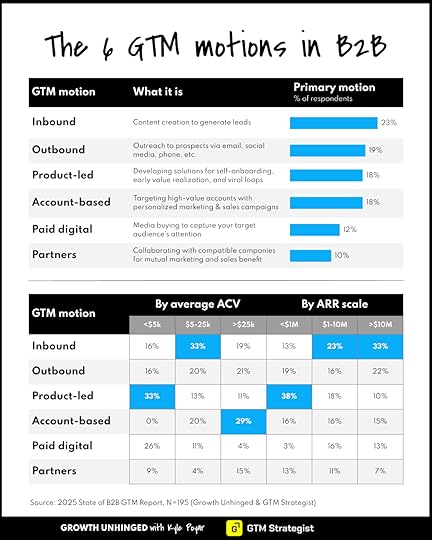
Interestingly, the report found no correlation between GTM motion and growth rate.
Every motion can work if you do it right. 🤠
 6 GTM motions with examples of companies that excel in them
6 GTM motions with examples of companies that excel in themWhen asked for their top challenge, 36% of respondents said “scaling GTM motions and pipeline,” followed by “increasing conversions” (19%), and “GTM efficiency” (11%). Less directly ROI-related areas, such as positioning and messaging, differentiation, pricing and packaging, and becoming “AI native,” are in the second plan.
You can think about this from first principles:
WHAT do we want? Better results, ROI.
HOW will we get them? By nailing positioning, pricing, and becoming AI native. 🤷
That gap says a lot about where teams are spending time — and where they should be spending it.

That’s great. But what exactly should I do or plan for 2026?
For those two that might not understand the difference:
GTM Motion = a predictable and scalable way to get customers
GTM Motion > Channel :))
GTM Motion ⋍ proven combinations of channels, tactics.
Now, let’s dive into what channels and tactics have worked well for the companies and find some good candidates for your 2026 investments.
2. The Channel Scorecard: What works best & follow the money to figure out what is nextSimilarly to GTM motions, there ain’t no “silver bullet” channel either.
The 2025 GTM Scorecard paints a crowded picture.
Reportedly, these are the channels that work best for certain groups of companies:
For companies over $10M ARR: large conferences, SEO, and paid ads
for $1–10M ARR: warm outbound, LinkedIn, and intent-based outbound
for under $1M ARR: LinkedIn, warm outbound, and founder brand.
And based on the ACV:
For deals over $25K: large conferences, intimate events, and warm outbound;
for $5–25K: warm outbound, large conferences, and SEO
or under $5K: SEO, paid ads, and LinkedIn.

Sounds rather old school - doesn’t it?
Well, there is nothing wrong with old-school if it is working well, but it is good to have at least 10-20% of GTM/marketing budget out there to “future proof” your company and take a screenshot now because this is the money shot 📸 - here are the “hot and new channels”:
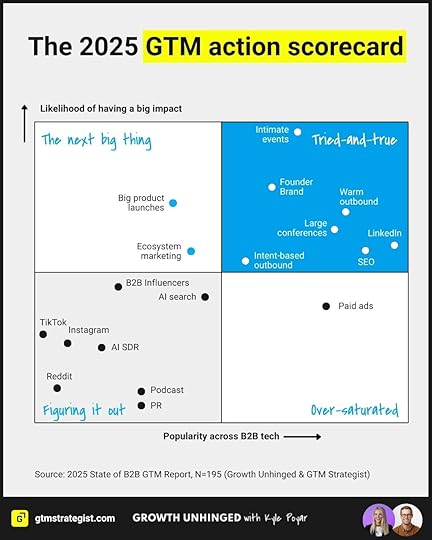
As a trained marketer, I do have some commentary on this.
Over-saturated: Paid ads, I get it, it is tough, and it is not gonna get easier - constant ROI battle with ad creatives, platforms, and delivery mechanisms. It still works, though, but get ready for massive experimentation, and have a testing budget ready.
Figuring it out: AI search and its current correlation with Reddit make this opportunity interesting and trending. While I think there are some leftovers of Gary Vee and Chris Walker playbook or “content repurposing machines” - which was popular like 5 years ago in B2C but is now eaten by AI, so unless GenZ and decision makers will have massively different channel preferences than we do, that is not where my money is. Now interesting: AI SDRs - Kyle pulled this statement from one of the survey responses: “We tried an AI SDR for six months and were unable to generate a single opportunity.” There is a lot of talk - little action. Although I do know teams that do it very well.
The next big thing: While I was happy to see ecosystem marketing there, like Emily Kramer a year ago 🔮 - I do not understand precisely what big product launches mean - Apple events, GPT-5, Sora ??? 😄
Follow the money is the logic that takes me the furthest in life and business.
When it comes to GTM channels where respondents plan the most significant investment increases, two big winners are AI search (AEO) and intent-based outbound. Intent-based is the new paradigm in outbound because the only person who has not reported diminishing returns on pitch-slapping mass widely available contact bases is Sir Nigerian Prince 👑.
These are the two fronts where I’ll definately do purposeful experiments in 2026.
What else do you see here that you like or don’t like?
Let me know in the comments! Substack is much more fun when I hear back from you.
Back to Hype Machine: GTM AI - time to show some ROI, baby!
3. AI adoption in GTM is mainstream, but its impact is uneven74% of companies say they have a top-down AI adoption mandate (28% hard, 46% soft). Yet only 24% report a “big impact from AI.” Kyle managed to pull some statements from the responses of those who are underwhelmed with the impact and of “the believers”.

Where AI is driving the most value was the next logical question to ask. From our survey findings, there are three groups where AI is already showing a satisfactory impact on GTM.
#1 - Outbound
Intent-driven outbound: deanonymizing website visitors, reaching out quickly with a tailored message
Automated SDR: messaging experiments, inbound qualification, and demo booking
Account targeting: identifying ‘look-a-like’ accounts, custom AI agents for lead scoring
AI agents on the website: chat agents to convert website leads and book meetings
#2 - Market intelligence
Competitor analysis: aggregating signals from competitors, AI agents to analyze win/loss data
Account insights: custom GPTs for meeting preparation, automated hand-offs from SDRs to AEs to CSMs
Data enrichment: AI-powered data enrichment and classification
#3 - Content marketing
Content generation: generating SEO-focused blog content, repurposing webinars into blog and social posts
GTM documentation: writing sales playbooks, call scripts, persona documentation, knowledgebase materials
Personalized messaging: AI-powered variables for email personalization
It was interesting to learn that almost every respondent (91%) uses mainstream AI tools such as ChatGPT, and 56% have deployed custom GPTs. I am still not sure if that number includes projects and shareable projects too - but that is another secret I’ll never know 🙂
Other BIG categories of tools are vibecoding/prototyping tools (41%), AI agents (41%), and multi-agent workflows (21%). The high use of AI agents came as a pleasant surprise to me, but, then again, I suspect this is connected to the loose use of the term.
To me, an agent self-learns and performs actions autonomously, but lately I’ve seen a lot of n8n workflows being baptized as agents, even though they don’t go beyond LMS automations.
Rant over - I like agents, I just don’t like to overhype their usage to something that would be quicker and cheaper to do with Zapier. Because if that becomes “the taste of agents”, they will surely not live up to the hype.
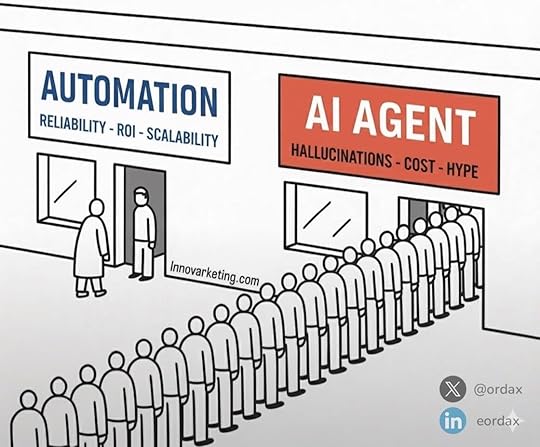
And this is a brilliant hook for the next section of the report. I’d like to present you: the tools. 🛠️
4. The 2025 GTM Tech StackKyle was really clever to ask these questions in two ways:
What are the most impactful GTM tools for you NOW?
What are the “MUST TRY” GTM tools for the future?
Observe these two slides for a sec:
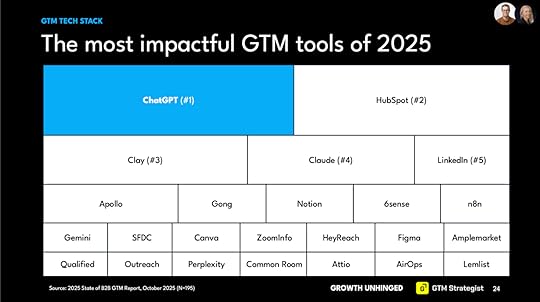
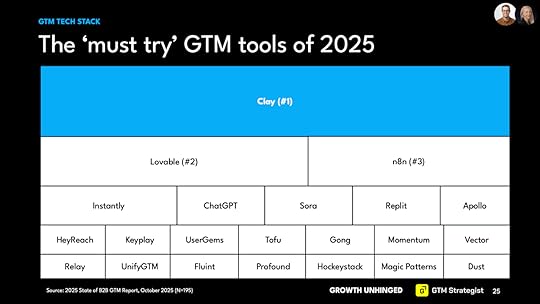
In the “most impactful” category, you’ll see a rather typical B2B toolset - how we run our processes, mainly mature tools and AI models + mainstream solutions. Some purposefully built GTM tools did pop up, but mostly, the fundamental layer of how we run our GTM operations.
Seeing this made me think of a super-interesting interview Lenny did with Brian Balfour, where he predicted it will that ChatGPT will be the next mega growth channel.
The must-try gets really interesting.
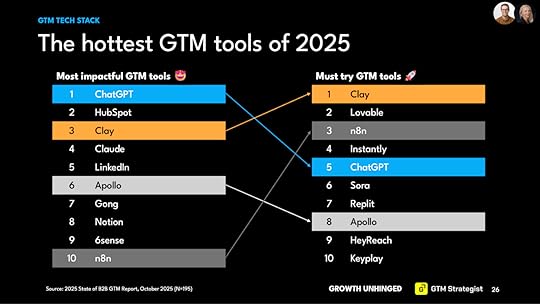
Clay jumps to #1, signaling that enrichment and automation are becoming the new GTM superpower. Lovable (#2) and n8n (#3) rise as symbols of the AI-native wave, and we see more AI native GTM tools popping up.
To me, the message is clear: the GTM tech that got us here won’t get us there. We should experiment with the new tools purposefully because we will be held accountable for the ROI of these implementations.
While LinkedIn is debating whether GTM engineering is a bug, not a feature, a symptom of tool complexity and unpredictability, I don’t care much how it is called. I am happily building my agentic and non-agentic n8n workflows. I remember vividly when GTM practitioners were skeptical if we could use ChatGPT reliably in 2023. Now more than 91% of folks who answered the survey rely on it.
5. What to double down on in 2026The closing message of the report is unambiguous:
2025 was a year of endless exploration.
2026 must be the year of ruthless scaling.
We no longer have GTM motions in single-player mode; it’s now multiplayer.
Allbound, ABX, mixbound, however you want to name it - modern GTM systems respond to real-time buyer intent. GTM motions need to be orchestrated around the buyer’s journey.
AI brought predictive intelligence to the mix, enabling us to detect and reach prospects much sooner with more tailored messages. So can our competitors. Detecting high-quality signals has become the new oil, and we need a technical stack and the capacity to capture them first.
In the age where buyers are discovering our brands in answer engines' zero-click environment, and entry barriers to producing decent content with AI are close to nada, we have to recall that every trend has an anti-trend.
In the age of AI content commodities, AI clones, mass production and cluttered inboxes of overwhelmed decision makers, trust, brand, intimacy, a really unique point of view, and indisputable credibility of talking human truth inherently become more valuable. Not a luxury per se, but that can become an intangible asset. Yes, invest in your AI tech skills, but also invest in your brand, your relationships with trust centers (partners, opinion leaders, relevant communities, tastemakers), and your customers. Think beyond touchpoints in their customer journey; create trustpoints - those experiences that buyers remember for months, years, and lifetimes.
Thanks again to Kyle Poyar for initiating this research, and all of you who kindly participated in this research. 🙏 This writeup would not have been possible without your help.
I’d love to learn what your key takeaways were from this report.
What do you see in your business?
What do you disagree with?
What surprised you?
I hope to exchange some good thoughts in comments, and if you’d like to support Kyle’s work, you can do so by subscribing to his paid Substack and you’ll immediately get the full 30-page report.
If you like what I share here and want to support the mission, sponsorship support, and your purchases of our digital products support design, content creation, and distribution efforts to keep the GTM Strategist Substack (hopefully) interesting and valuable. ✌️

📘 New to GTM? Learn fundamentals. Get my best-selling GTM Strategist book that helped 9,500+ companies to go to market with confidence - frameworks and online course included.
✅ Need ready-to-use GTM assets and AI prompts? Get the 100-Step GTM Checklist with proven website templates, sales decks, landing pages, outbound sequences, LinkedIn post frameworks, email sequences, and 20+ workshops you can immediately run with your team.
🏅 Are you in charge of GTM and responsible for leading others? Grab the GTM Masterclass (6 hours of training, end-to-end GTM explained on examples, guided workshops) to get your team up and running in no time.
🤝 Want to work together? ⏩ Check out the options and let me know how we can join forces.
October 24, 2025
How Glasp Grew to 3.5 Million Users Organically
Dear GTM Strategist,
AI didn’t just change how we create - it’s changing how we learn.
Few teams understood this as early, or as deeply, as Kei and Kazuki, the founders of Glasp.
From a hospital bed in Japan to 3.5M users worldwide, their story is a masterclass in what organic growth means in the age of AI:
Building for curiosity, not just clicks.
Letting small experiments go viral.
Turning human knowledge into something that lasts.
From building one of the first ChatGPT-based Chrome extensions to figuring out AI search (AEO) - everything based on a sound business strategy and understanding users’ needs.
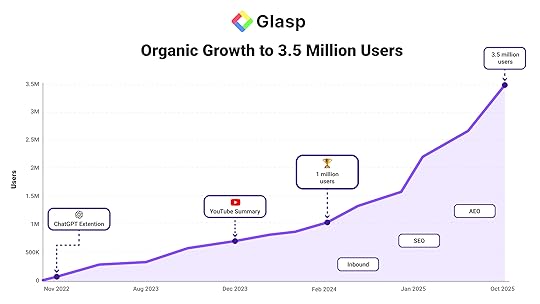 caption...
caption...That’s why I invited them to present their case in this week’s GTM Strategist newsletter.

Welcome to the AEO goldrush!
Based on the survey we did with Kyle Poyar, a stunning 51% of GTM practitioners plan to increase their investments in AI engine/search optimization (AEO) in 2026 (full report coming next week!).
Ahrefs is leading this transition with Brand Radar - a tool to help you track your brand’s visibility in AI search in ChatGPT, Perplexity, Google’s AI Overviews, and other major chatbots.
P.S.: Glasp is their happy customer, too.
Now, let’s hear it from Kei and Kazuki 👇
We’re Kei and Kazuki, co-founders of Glasp - a social learning platform that helps people capture, organize, and share what they learn online.
We also built YouTube Summary, which uses AI to transcribe and summarize videos so anyone can learn faster and more effectively.
Over the past few years, Glasp grew to over 3.5 million users, entirely through organic discovery — no ads, no affiliate deals, no paid campaigns.
In this post, we’ll share how it happened:
How we anticipated the coming AI wave before ChatGPT’s breakout.
How YouTube Summary went viral and created a new category.
How we evolved from summaries to AI Clones, making human knowledge interactive and lasting.
How we scaled with Programmatic SEO, and finally,
How we began exploring AEO (Answer Engine Optimization) — the emerging frontier where models, not humans, become your audience.
Each phase wasn’t a “growth hack.” It was a small, continuous experiment that changed how we understood what “organic” really means in the age of AI.
1. How Glasp StartedAt 20 years old, Kazuki, a co-founder of Glasp, faced a near-death experience.
A sudden subdural hematoma paralyzed the left side of his body, and doctors told him he could go into cardiac arrest at any moment. Lying in that hospital bed, he wasn’t thinking about success or ambition — he was haunted by a single question:
Had I left anything behind that truly mattered?
 This is a CT scan of his brain from that time. The white area represents blood.
This is a CT scan of his brain from that time. The white area represents blood.Surviving that moment changed everything. He realized that knowledge is one of the most valuable things we accumulate in life, yet it often disappears when we do. The books we read, the insights we gain, the lessons we learn — most of it fades into private notebooks, never to be shared, never to benefit others.
Later, after co-founding his first startup and experiencing a painful split, Kazuki turned to books for guidance. He read over a hundred works from history’s greatest thinkers and realized something profound: while technology evolves, human nature doesn’t.
Across centuries, people have wanted the same thing — to leave something meaningful behind.
So he began to wonder:
What if we could democratize knowledge — make it visible, interconnected, and built upon?
That question became the foundation of Glasp — short for Greatest Legacy Accumulated as Shared Proof.
We built Glasp with a simple but profound mission: to democratize access to the learnings and experiences people collect throughout their lives — turning them into a utilitarian legacy for others.
We wanted to take knowledge out of private silos and bring it into the open —
to help people see what others find meaningful, and to build a collective intelligence that transcends generations.
By mid-2022, we could sense something brewing. Transformer models were improving fast, developer chatter was accelerating, and it felt like conversational AI was about to cross into the mainstream.
So when ChatGPT launched in November 2022, we didn’t wait. On the very same day — or perhaps the day after — we released a tiny Chrome extension called ChatGPT Extension.
It was absurdly simple: about 20 lines of code. All it did was float ChatGPT on top of any webpage using an iframe. You could read an article, highlight a phrase you didn’t understand, and instantly ask ChatGPT about it — without ever switching tabs.
Despite its simplicity, it went viral. Within a week, it hit 100K–200K installs, becoming the #2 most popular ChatGPT-related extension in the world.
That experience taught us two lessons we still live by today:
Move fast, even with imperfect ideas. The wave itself can carry you.
Tiny experiments can punch far above their weight.
The success of ChatGPT Extension didn’t just give us users — it gave us momentum, visibility, and infrastructure we could reuse. When we later spotted a new opportunity around YouTube transcripts, that foundation allowed us to act instantly.
3. The Breakout: YouTube SummaryAfter ChatGPT’s debut, the ecosystem exploded overnight with “ChatGPT × X” products — PDF summarizers, Gmail assistants, WhatsApp and Twitter bots, Google Search overlays — everything imaginable.
We stepped back and asked a simple question:
What’s the underlying pattern here?
At that time, ChatGPT only supported text — image input wouldn’t arrive until GPT-4 in March 2023 — so the opportunity space was limited to what could be done with text alone.
And fundamentally, GPT could do two things with text:
Expansion — generate, rephrase, elaborate.
Contraction — summarize, shorten, extract key points.
So we began mapping which media formats had been tackled (PDFs, emails, web articles) — and which hadn’t. That’s when we noticed something obvious yet overlooked: YouTube transcripts.
Glasp already supported highlighting YouTube transcripts. That gave us an instant advantage. If the transcripts already existed, why not summarize them?
No one else was doing it, and the potential demand was massive. That realization became the seed for YouTube Summary.
Why We Launched It as a Separate ExtensionAt the time, the original Glasp extension had about 30K installs. But we knew that Chrome Web Store updates could take weeks to review — too long when the market was moving daily.
So we made a strategic call: launch YouTube Summary as a completely new extension. New extensions typically get approved in a day.
Technically, it was simple: it fetched the YouTube transcript and passed it to the user’s own ChatGPT window. Since the ChatGPT API hadn’t been released yet (it arrived later in March 2023), building on the web interface was the only practical option.
We didn’t use the GPT API directly, and that decision came with three major upsides:
Speed: No backend integration meant we could ship instantly.
Zero cost: No API fees — critical since we weren’t monetizing.
Low friction: Free access made it appealing to anyone.
The tradeoff? We couldn’t store user context or chat history — something we’d later realize had strategic value for personalization. But at that moment, speed > perfection.
From Zero to One Million InstallsThe results were immediate. YouTube Summary took off even faster than ChatGPT Extension — hitting tens of thousands of installs within days.
By February 2024, just 14 months after launch, it had crossed 1 million installs — all with zero ad spend.
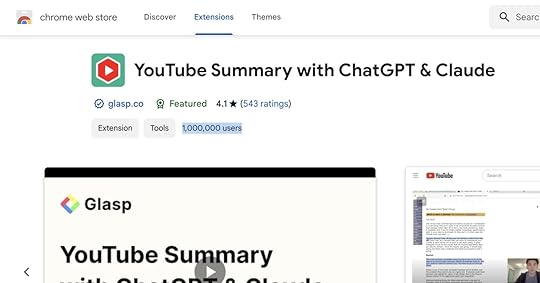 Kazuki Nakayashiki’s X post
Kazuki Nakayashiki’s X postHow did it spread?
Social virality: Influencers on X and LinkedIn with hundreds of thousands of followers shared it organically.
YouTube amplification: Creators with 200K–2M subscribers showcased it in their videos.
Press coverage: Forbes, Microsoft News, Business Insider, and Lifehacker amplified awareness even further.
Compared to the year it had taken to reach 30K users pre-ChatGPT, the difference was night and day. With YouTube Summary, it felt like undeniable product-market fit — growth was happening on its own.
We’re still deeply grateful to everyone who helped spread it 🙏
4. From YouTube Summary to AI Clones — Making Knowledge InteractiveAfter the breakout of YouTube Summary, we started asking a deeper question.
If Glasp could help people capture what they learn, and if AI could use that knowledge — then could we make people’s learning itself accessible, interactive, and enduring? That question led to our next big bet: AI Clones.
What an AI Clone IsAn AI Clone is your personal chat agent, grounded entirely in your Glasp highlights — from the web, PDFs, and YouTube. You can ask it questions, and it answers with citations to the exact passages you’ve highlighted.
If you choose, you can even make your clone public — letting others query your knowledge directly. For example:
“Hey Kei, what’s the best article you’ve read on product management?”
“I’m stuck on a startup issue — what would you do?”
We released the first version of AI Clones in December 2022, about a month after ChatGPT went live.
The timing mattered. Human expertise is scarce; calendars are even scarcer.
A public clone lets millions ask questions in parallel, pushing our mission of democratizing access to human knowledge one step further.
Most of humanity’s knowledge remains locked in people’s heads and disappears when they pass away. With nearly eight billion people alive today — and almost none around a century from now — we risk losing vast reservoirs of insight. Many of tomorrow’s challenges have already been solved by someone, somewhere, yet that wisdom stays isolated.
Glasp exists to change that. Highlights signal what truly mattered to someone, and AI Clones turn those signals into interactive, lasting resources. By circulating knowledge instead of letting it vanish, we aim to help individuals and society move forward faster.
On a personal level, knowing that your experiences contribute to others’ growth gives life deeper meaning. And on a broader level, we’re curious about what experts actually read and learn from.
If you can’t ask Bill Gates or Elon Musk directly, could you still learn from the sources they’d highlight? AI Clones make that possible — transforming private learning into shared, living knowledge.
5. Scaling With Programmatic SEOWhen YouTube Summary took off, it didn’t just become a feature — it created a new category. But as novelty faded and copycats appeared, we faced a challenge: how to sustain growth, defend our position, and expand the market — on a near-zero marketing budget.
That constraint forced us to think in two stages:
Media reach to raise awareness and Domain Authority (DA),
Programmatic SEO to compound visibility across evergreen, learning-focused topics.
From Media Reach to Compounding VisibilityAt first, we focused on media. Outlets like Forbes and Business Insider were eager to cover new, useful AI tools, and that coverage gave Glasp both credibility and backlinks — a foundation for long-term visibility.
But once the “novelty wave” faded, we needed a scalable engine. That’s when we turned to Programmatic SEO, systematically transforming YouTube transcripts into searchable, indexable Q&A-style articles.
The SystemIdentify evergreen, educational YouTube channels (TED, Stanford, etc.).
Fetch video metadata and transcripts.
Use GPT-3.5 to summarize and convert them into Q&A articles.
Embed FAQ/QAPage schema (JSON-LD) for structure.
Add everything to our sitemap for automated indexing.
The Q&A structure wasn’t random — we’d noticed both from ChatGPT usage and Quora’s Poe launch that question-answer formats were inherently more discoverable, both for humans and for LLMs.
Results & LearningsTraffic: Cloudflare logs showed over 2M+ weekly requests from AI crawlers (Gemini, OpenAI, Anthropic).
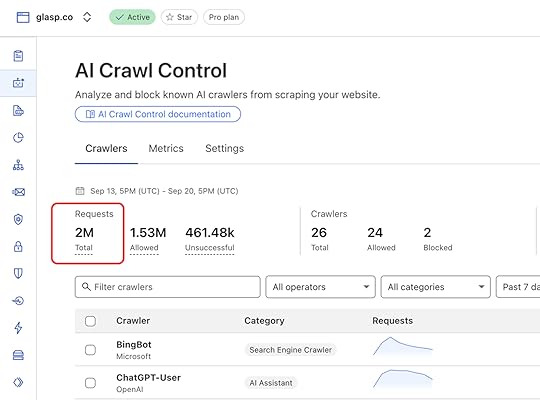 Kei Watanabe’s X post
Kei Watanabe’s X postSearch Console: ~2.2M impressions / ~14.7K clicks in 28 days.
 Google Search Console showing impressions and clicks from YouTube content.
Google Search Console showing impressions and clicks from YouTube content.Media mentions: Our auto-generated Q&A articles were cited by Wikipedia and Big Think — without any outreach.
While human CTR was modest (reflecting GPT-3.5-era content quality), crawler activity was massive — an early sign of what we’d later call LLM SEO.
In hindsight, the decision to embed Q&A formats early paid off. It positioned Glasp for the next frontier: optimizing not just for people, but for models that learn from people.
6. From SEO to AEO — The Memory LayerBy 2025, AEO (Answer Engine Optimization) — sometimes called GEO (Generative Engine Optimization) — was starting to gain attention. It builds on SEO’s foundation: clean structure, high-quality content, clear schemas.
But within AEO, we noticed a hidden layer that few were talking about —a growth surface quietly emerging inside LLMs themselves.
We call it the Memory Layer.
While most teams focus on how to appear in AI answers, we started asking:
What if the real opportunity isn’t just being cited — but being remembered?
If LLMs increasingly retain context about users and the sources they engage with,
then optimizing for model memory could become a new kind of growth advantage — one that compounds invisibly over time.
When ChatGPT introduced its Memory feature in early 2024, we kept an eye on how it might reshape discovery. By mid-2025, we decided to test it ourselves.
If enough users naturally encountered “Glasp” in relevant prompts — say, “YouTube summary Glasp” or “highlight with Glasp” — would the model start remembering us and re-suggesting our content later?
To explore that, we ran a small, ethical experiment through our ChatGPT Extension used by YouTube Summary users.
For free users only, we lightly modified the default prompt to:
Check if a Glasp summary already existed.
If yes, cite it; If not, generate a new summary and add a “Learn more on Glasp” link.
Here’s the actual prompt we used:

All prompts were opt-out, reversible, and clearly aligned with user intent. We weren’t trying to drive traffic — we wanted to understand how models learn from repeated brand mentions.
What We ObservedHuman traffic: Almost unchanged. Most users finished inside ChatGPT — the summary was “good enough.”
AI crawler traffic: Surged dramatically. Cloudflare logs showed millions of hits from OpenAI, Anthropic, and Gemini fetching Glasp pages.
Attribution: Ambiguous, but suggestive. The rise in crawler activity mirrored the experiment timeline.
We didn’t see an immediate growth unlock — but we did glimpse a new kind of retention. If SEO is about being found, AEO is about being recalled.
And inside that, the Memory Layer may be the most under-explored growth surface today.
Measuring “AI Visibility”To dig deeper, we built a small internal simulator — sending thousands of synthetic prompts to ChatGPT and Gemini to estimate how often Glasp appeared in responses.
The takeaway:
SEO visibility clusters around head keywords.
AEO visibility expands through long-tail conversations and follow-ups.
This mirrors how LLMs actually behave — reasoning across context, not just ranking by relevance.
Guardrails & TakeawaysWe ran the Memory Hack carefully: transparent, reversible, and user-aligned.
A few users noticed the prompt tweak; most didn’t.
But the insight stuck with us: the competition for attention is moving from the search index to the model’s memory.
Most people see AEO as a buzzword. For us, it’s a living experiment — and the Memory Layer might be its most powerful (and least understood) growth lever yet.
The next frontier of growth isn’t just about visibility. It’s about persistence.
Looking back, each phase didn’t replace the previous one — it built on it. YouTube Summary unlocked accessibility, AI Clones brought persistence, Programmatic SEOscaled discovery, and AEO opened an entirely new layer. Together, they formed a continuous loop: learn, publish, and be remembered.
7. Lessons Learned — What Compounds Over TimeAcross every phase of Glasp’s journey — from viral moments to quiet experiments — a few principles kept proving true.
Speed matters. Platform shifts reward those who ship fast, not those who ship perfect. Momentum compounds when you learn in public and iterate in real time.
Stay curious and pattern-match. Keep researching across fields that genuinely interest you. Spot where energy is shifting — and be ready to place a bet when a new wave forms.
Think long-term. There will be times you need to move fast for short-term signals, but always anchor your direction in the long arc of where the world is heading. Identify the domains worth investing in for years, not weeks.
Invest in what compounds. Growth happens when your effort keeps working after you stop. For us, that means putting resources into content, systems, and people — the assets that build flywheels, not funnels.
In the end, we learned that sustainable growth isn’t about chasing hacks — it’s about building the things that keep learning, scaling, and compounding over time.

📘 New to GTM? Learn fundamentals. Get my best-selling GTM Strategist book that helped 9,500+ companies to go to market with confidence - frameworks and online course included.
✅ Need ready-to-use GTM assets and AI prompts? Get the 100-Step GTM Checklist with proven website templates, sales decks, landing pages, outbound sequences, LinkedIn post frameworks, email sequences, and 20+ workshops you can immediately run with your team.
🏅 Are you in charge of GTM and responsible for leading others? Grab the GTM Masterclass (6 hours of training, end-to-end GTM explained on examples, guided workshops) to get your team up and running in no time.
🤝 Want to work together? ⏩ Check out the options and let me know how we can join forces.
October 17, 2025
4 AI Agents for LinkedIn: Research, Engagement, ICP Extractor and Coach
Dear GTM Strategist!
We spent some amazing time in the United States attending the Miro Canvas 25 event, learning about AI from frontrunners in the space. Miro just launched Sidekicks, MCPs and Flows (demos coming soon!), Intercom adds 1M+ a week to their revenue relying on outcome-first pricing (Fin), AWS shared lessons learned from AI-transformations of their companies, and we visited Clay offices to meet senior GTM engineer Alex Lindahl and Clay’s head of marketing, Bruno Estrella.
Thanks for reading GTM Strategist! Subscribe for free to receive new posts and support my work.
It will take me a while to collect all thoughts and learnings, but one thing I can tell you is - less talking - more doing 💪. The only way to see what value AI can bring to your GTM is to strategically implement it where it can bring tangible results - not saying that we are “AI first” because our LMS writes reports that are read by other LMS 😏
Our trip to the USA was entirely planned by ChatGPT - it selected hotels, restaurants, and daily itineraries for us - no human in the loop :) Don’t wait out on GEO (generative engine optimization) - check how your brand is doing in Brand Radar by Ahrefs and start optimizing your presence in engine answers now. You can make an impact faster than ever - be early to explore this new platform opportunity before it gets crowded and dominated by big brands.

This post is sponsored by Ahrefs - a leading SEO & marketing intelligence platform that helps you accelerate the growth of organic traffic to your website.
With Brand Radar by Ahrefs, you can now track your brand’s visibility in AI search in ChatGPT, Perplexity, Google’s AI Overview, and other major chatbots.
Now, let’s tackle the main topic of today’s newsletter: I wanted to share with you how I’m coding my AI agents that help me with my LinkedIn activities.
Recently, I hit 70K followers on LinkedIn, but I did not feel like celebrating much.
In 2025, LinkedIn got tough.
Some creators saw up to 90%+ decrease in organic engagements.
We see posts that are 3 weeks old in timelines.
Automations are punishable offenses now 👮
It still works, though - 70%+ of my pipeline is from LinkedIn or LinkedIn-assisted.
But in Q1/Q2, I slowly lost passion for it.
Surrounded by people claiming how they booked 50 meetings and created $1mio pipelines with their outbound automations, it felt like the only human left on LinkedIn talking to AI-generated comments. Got really bored and frustrated.
I wanted to make it fun again.
The recipe to do well on LinkedIn is “simple”:
✅ Publish great content - define great 🤖
✅ Create “relationships” - these days, that means 30-50 comments a day
✅ Engage - do not “post & ghost 👻” - you need to be there kicking off conversations
The problem?
This is so resource-heavy and questionable in terms of ROI and opportunity cost:
Most well-admired content creators spend 20-40 hours a week optimizing the algorithm and speculating which Canva designs will perform well this week.
Others pay $5,000- $20,000 per month for ghostwriters, LinkedIn designers, and assistants to write comments on their behalf.
Third, participate in engagement pods - you’d be surprised how many are out there - some excellent quality (industry experts supporting each other), others bot farms.
None of these options seems sustainable to me.
But what do we like?
AI 🤖
So, I invited my team on a mission: let’s build a multi-agentic system, and bring all the relevant notifications to our Slack.
Requirements:
Spend $0 on external tools (everything self-hosted and custom-coded)
Avoid all tools and methods that we know have gotten people kicked off LinkedIn
Have a working prototype ready in a week.
Avoid no-code tools that burn credits faster than I can eat a bag of crisps on my cheat day.
The vibe-coding week has begun, and I am happy to introduce you to four AI agents we have developed, tested, and even validated for our client portfolio.
1. Research AgentOld way: I spent 1-2 weeks preparing a good-looking moodboard of the best-performing LinkedIn posts that informs my content strategy. It was a very labor-intensive process of manually going through posts, screenshotting them, writing down their data and arranging them in a Miro board.
Problem: I could only do that once a quarter because it burns too many resources.
Mission: Run this analysis once a month on selected profiles to create faster feedback loops for content creation and design - inform me on Slack when the new analysis is made.
Solution: n8n automation that gets posts from select profiles, analyzes their data (engagement, time of posting, posting frequency), automatically screenshots the top posts and presents the data, graphs and the AI analysis on a Miro board with API.
How it works:
When triggered, the automation retrieves a list of LinkedIn profiles from Google Sheets and fetches their recent posts via HTTP requests to our API.
Posts are saved to the database, then the flow splits into two parallel processes:
Aggregate analysis: Creates overall data charts and visualizations summarizing trends across all profiles.
Individual analysis: Loops through each profile to generate personalized charts, screenshots of top/worst posts, and mini visual reports.
An AI agent with memory and vector search capabilities analyzes the post data from Supabase to extract insights and findings for each profile.
Once all processing is complete, the graphs, screenshots and insights are sent to a Miro board via their HTTP API.
I get a notification that the analysis is ready in a Slack message.
 Workflow for my Research Agent in n8n
Workflow for my Research Agent in n8nResult: This lovely moodboard is now created in less than a day, whenever I want it. I can run this analysis now for clients on their specified clusters that act differently from influencers that I am monitoring - instead of sharing “standard algo reports and what works for us,” we can tailor specific insights to them.
 Output: all analytics and a moodboard of top-performing posts on a Miro board2. Master of Engagement
Output: all analytics and a moodboard of top-performing posts on a Miro board2. Master of EngagementOld way: I ring a bell on the content creator’s profile that I like - then I get a notification (or not!- LinkedIn notifications are really odd) and then before I post, I write a couple of comments under relevant profiles in my industry.
Problem: I do not get all the notifications, I am often late to the party because I get notifications late - only when I open LinkedIn, buried with all the other notifications.
Mission: Get me relevant posts to comment on 1x a day on Slack so I can have a curated view and just “go, go, go” and comment without scrolling through the newsfeed and figuring out what to comment on.
Solution: n8n automation that runs twice an hour and checks if the profiles I want to engage with have any new posts. The notification is sent to me in a Slack channel so that I can get notified when a new post is out or just check the channel whenever I want to see what has been posted.
How it works:
I have a list of profiles that I want to receive notifications on, saved in a Google Sheets document.
The automation retrieves the profiles from the sheet and checks for new posts from them using a custom-coded LinkedIn API.
If new posts are found, they’re split out and processed in a loop where JavaScript code formats and enriches the data.
The formatted posts are aggregated and sent to me via Slack notification.
If any errors occur during the profile checking process, I receive an error alert in Slack so I can investigate.
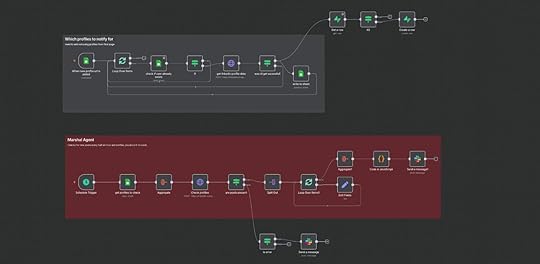 Workflow for my Engagement Agent in n8n
Workflow for my Engagement Agent in n8nResults: Peace of mind, so I do not have to worry if I captured all the relevant posts or facepalming about nonsensical posts pushed by the algorithm to my timeline that make me lose faith in humanity :)) + some of my comments get more impressions than my posts, which attracts new people to our ecosystem.
 Output: Slack notifications with preview texts, engagement metrics, and a link to each post3. ICP Finder
Output: Slack notifications with preview texts, engagement metrics, and a link to each post3. ICP FinderOld way: Do it with Clay + HeyReach (I still like this one a lot, the problem is that you have to set up campaigns for separate post URLs, and that is time-consuming + costs like $228/month, so if that is the only campaign you’d run, that is ROI-questionable. Both great tools btw!
Mission: Get me a list of ICP-qualified leads for posts that I want.
Solution: This n8n automation checks whether i have a new post and then checks for new reactions. Each profile gets analyzed and its description classified based on how it fits our ICP. For now, we only work on perfect ICP matches. The agent compiles the best matches and sends a message to a Slack channel on whom to reach out to on LinkedIn.
How it works:
The automation retrieves my latest post and all the reactions it received via our custom API.
Reactions are saved to the database, then an AI text classifier evaluates each person’s profile description to determine if they match our ICP (Ideal Customer Profile).
Based on the classification (Perfect Match, Good Match, or Not a Match), their database record is updated accordingly.
An AI agent with memory analyzes the matched profiles, selects the top 15 prospects, and generates the message formatted in Slack’s Block Kit.
The top prospects are sent to me in a Slack message.
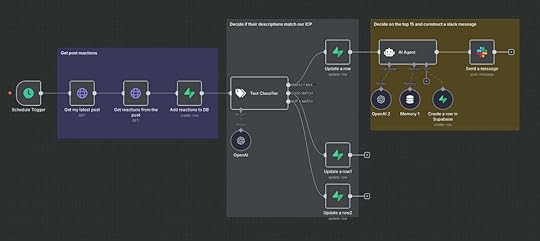 Workflow for my ICP Finder Agent in n8n
Workflow for my ICP Finder Agent in n8nValue: Endless prospecting opportunities - I do not have much capacity in Q4, so I use this one very selectively, but it works like a charm for clients and helps them book more meetings and secures fast ROI to their investments in LinkedIn presence.
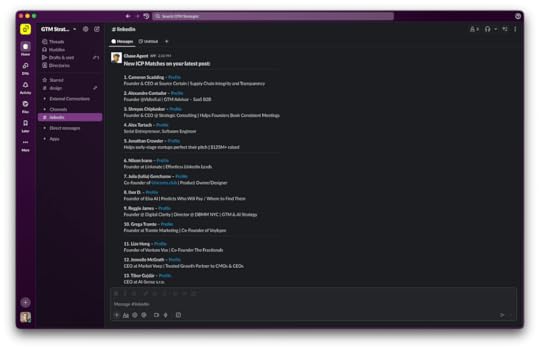 Output: A list of ICP-match LinkedIn profiles in Slack4. LinkedIn Coach
Output: A list of ICP-match LinkedIn profiles in Slack4. LinkedIn CoachOld way: Periodically, when things do not go well, I go back to the drawing board and refine the strategy - very random and needs-based.
Mission: To have a structured feedback loop of what works well for me and other creators so I can always learn and improve.
Solution: An n8n automation that gets the posts from relevant profiles every 7 days and uses an AI agent to analyze best practices, best times to post, what performed well, and what did not.
Tagging the bot on Slack also allows me to chat with this coach to get more into the nitty-gritty if I have more questions.
How it works:
I submit a list of profiles I liked to a Google Sheets document.
An n8n automation gets the posts from these profiles every 7 days and saves them to the database.
An AI agent using the OpenAI Model uses the Supabase and the dynamic sql tool to get data it needs to perform the analysis. We use a simple memory so that the AI has a glimpse of previous executions.
Once the analysis is ready, the insights are sent to me in a Slack message.
I can also proactively chat with this coach and ask follow-up questions, request a specific analysis, or to add more profiles to the list.
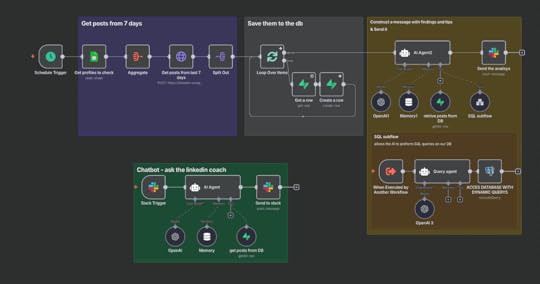 Workflow for my LinkedIn Coach Agent in n8n
Workflow for my LinkedIn Coach Agent in n8nValue: It feels like having a coach there for me, providing me with tips and inspiration whenever I get stuck.
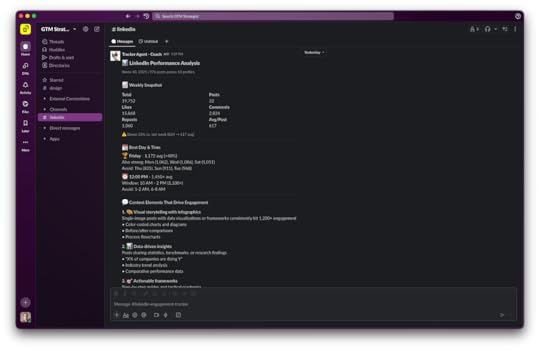 Output: My weekly report with the analysis of best LinkedIn practices.5. Supervisor agent
Output: My weekly report with the analysis of best LinkedIn practices.5. Supervisor agentTo help all 4 AI agents work together and deliver best results, we are also building a supervisor agent (this one is still work-in-progress).
This agent allows me to interact with all the other agents through Slack. The n8n agent node sends requests through tools to all the other agents so that we collect the data and insights. This supervisor agent will also be able to provide relevant answers based on the gathered data that the current agents perhaps do not present.
 This is how my agents work together
This is how my agents work togetherIt is a super fun project that made me slightly more passionate about “my life on LinkedIn” again.
If you want to DIY this - please go ahead, it is great.
If you’d like to chat about how to bring and streamline this intelligence into well-crafted marketing and sales process, you are welcome to ping me, but please note that this will only work once you are serious about content creation and have designated marketing and business development resources to create a scalable pipeline out of this AI-assisted workflow.
If you like what I do and want to support this newsletter, you can do so by recommending it to your peers, sponsor the edition or get some of our GTM solutions ✌️
More next week 👋

📘 New to GTM? Learn fundamentals. Get my best-selling GTM Strategist book that helped 9,500+ companies to go to market with confidence - frameworks and online course included.
✅ Need ready-to-use GTM assets and AI prompts? Get the 100-Step GTM Checklist with proven website templates, sales decks, landing pages, outbound sequences, LinkedIn post frameworks, email sequences, and 20+ workshops you can immediately run with your team.
🏅 Are you in charge of GTM and responsible for leading others? Grab the GTM Masterclass (6 hours of training, end-to-end GTM explained on examples, guided workshops) to get your team up and running in no time.
🤝 Want to work together? ⏩ Check out the options and let me know how we can join forces.
Thanks for reading GTM Strategist! Subscribe for free to receive new posts and support my work.
October 10, 2025
How AI Agents Actually Go To Market
Dear GTM Strategist,
We heard it all - haven’t we?
“AI killed PMF.”
“AEO - the end of SEO?”
“AI replacing humans in GTM.”
“AI polluted inbound and outbound dead.”
😴 I am getting bored …
While everything is burning and nothing seems to work - I find myself busier than ever and a little more interested in things that work than those that don’t 🤷. How about you?
Over the last 18 months, I’ve been working almost exclusively with AI products and supporting 37 AI agents in their go-to-market endeavors.
In this post, I’d like to acknowledge and demonstrate 4 key differences between the launches of AI agents and our traditional SaaS GTM playbook, which we have been using for the last decade or so.
I’ll walk you through 4 key lessons from my $200M ARR AI launches that worked well for the teams I work with:
Sales-led for the win in early stages
Pricing: think beyond credits
Ecosystem marketing creates leverage
AI-first GTM is how these teams win
For each, I will provide you with a case study/example, practical frameworks, and action points that you can apply with your team to AI agent launches (or even other products/services) if you see fit.

This newsletter is sponsored by ZoomInfo.
85% of enterprise sales reps manage their book in spreadsheets. Only 5% use CRM.
This isn’t laziness - it’s survival. When deal data is in Salesforce, calls are in Gong, and content is scattered everywhere, spreadsheets become the only unification layer.
ZoomInfo built ZoomInfo Copilot Workspace to fix this: one workspace with complete buyer context, CRM data, and intelligence on 100M+ companies. No more tab-hopping.
Execution wins deals. Everything else is just preparation.
 1. Sales-led for the win in early stages
1. Sales-led for the win in early stagesI mainly work with technical founders and very product-savvy teams that have a natural tendency to go “product-led”. Ideally, they’ll launch the product, post on a couple of social media channels, and then people will love it so much that they’ll invite others.
For most, that is wishful thinking.
The cruel reality is that we have to grind through warm intros, upselling existing client base, doing “old-school” sales, or even offering “done with you” product+service combos to get past first PoCs (proof of concepts).
There are 3 reasons why “big adoption” - even if the team manages to get it - could lead to BIG problems when it comes to AI agents:
State of tech: in the beginning, our agent might not be “there yet.” Workflows and automation break, it sometimes glitches or starts to “act off.” That is not ideal for self-serve users
User trust: “earn the right to automate, keep humans in the loop” has been the mantra of AI agents adoption in 2025. We usually start with a smaller pilot and if things go well, we expand. Most of us do not just let 200 agents into our CRM to “dance around” and send random emails.
Real adoption - real costs. Even if we manage to create a buzz, what you’ll see is that most agents do not have “30-day free trial” 😏 - you have to qualify for a demo. Why is that? Because AI credits (tokens) cost money, and if we have non-qualified leads “playing around with the product,” their activity has a much higher cost than the “costs of hosting” from the regular SaaS.
Now that we understand the problems of “PLG for AI agents”, let me share one of the tactics that has been working well for nearly all the companies I’ve been working with (even for $1B+ ARR companies): outreach with a case study.
It is so simple that I’m bluntly stunned that more people don’t use it:
Select a beachhead segment (short tutorial here)
Solve a problem really well for a customer.
Find more customers like that and proactively reach out.
Amplify this with marketing, PR, and event activities.

Momentum, the GTM orchestration platform, has been very successful with this approach.
Their client portfolio includes ElevenLabs and 1Password and they raised $13M in a Series A round in July 2024.
Seriously, check out their website - it is a masterclass of using social proof to build trust and interest.
 www.momentum.io2. Pricing: Think beyond credits
www.momentum.io2. Pricing: Think beyond creditsAs a user, I dislike the lack of transparency in the unpredictability of burning credits. If I purchase 10,000 credits from you, please inform me precisely what I will receive: how contacts will be enriched, emails generated, and what benefits I will gain. Oh, you said that these tasks burn different numbers of credits - come on, I just need to understand how much it will cost me and how to budget for it.
We all love outcome-based pricing (so that we charge when the client actually gets value), but with most AI agents, we are soooo far from it 😕

If the following questions sound familiar, it is unlikely that the customer will agree with usage-based or outcome-based pricing; we’ll have to determine a fixed number and start there.
“How much should I budget for that in 2026?”
“Can we lock in this price per licence for two years?”
“How can you guarantee that the cost is not going up later?”
“How much work can this agent really take away from us?”
“We need a sign purchasing order and run it through compliance.”
“We require 10% discounts from all our vendors.”
Many teams that I work with would even consider offering a fixed price for “done with you pilot” - just to get a foot in the door and an opportunity to demonstrate value to the client.
My core belief is that pricing should be simple enough for a user to understand how much they will end up paying for something and it is our job to figure that out - not theirs.
This is why I loved old Swan’s pricing page - as someone working in GTM I understand how much it will cost me and what do I get - and I know exactly what package is the right for me.

I had a similar reaction to this pricing page by ElevenLabs that has 7 packages, but I still somehow understand what package I should choose and what is covered.

So please don’t make me do the mental math.
Help me figure out how much I should budget for it in 2026.
3. Ecosystem marketing to create leverageI was super inspired by the growth journey of HeyReach (ecosystem partner themself). One of their earlier segments was agencies, and you do see a significant spike in adoption/validation after they made this call. How so?

For most companies, outreach is hard, and they would rather do it with a trusted partner (agency) than DIY with one of 10,000 tools out there. Agency partners play a significant role in the customer journey for the adoption of these tools by many companies.
And if things go well, one agency can potentially bring in 10+ customers :) And that is not a pyramid scheme, it is a perfectly legit GTM motion called partnerships and much more - as we will develop and explain in the continuation.
Inspired by this beachhead strategy (target agencies for faster adoption), our client, echowin launched a white-label AI voice-building platform for agencies. Think about voice agents for a sec - AI receptionist, AI support agents … usually they are used by service businesses (car repair shops, restaurants, legal offices, energy companies, etc.).
For most of these companies, marketing and tech are not their core business activities, so many would outsource the work to specialized vendors - agencies that are their trusted partners for adopting new technologies.

They launched the whitelabel program silently, creating a website section and posting about it on social media. Within weeks, over 238 agencies applied, many of them supremely qualified, but the team decided to let them in in batches of 10-15. Why? To make sure that they are successful in onboarding their clients. The stakes are high - each partner can potentially bring in 30-170 locations - but first, we have to support them in building a great pilot. You remember... Lesson #1.
There is more to it. Miqdad Jaffer, Product Leader at OpenAI, introduced this wonderful model of 9 advanced distribution tactics that create massive leverage for AI products (he shared this in The Product Compass Substack - must read!).
Which of those would play well for your product?
 4. AI-first GTM: 7 PLG loops for AI products
4. AI-first GTM: 7 PLG loops for AI productsAnd then, once you successfully grind through the first case studies and create a value delivery process, it makes your company “the factory of case studies” and figure out where leverage could be created on your customer journey - by all means - go BIG!
For AI products, we do not have 6-18 months to achieve go-to-market fit.
We have weeks, sometimes months, to find a proxy for product-market fit.
The AI technology landscape is changing rapidly, investor money is shifting the cards really fast and customer needs and preferences are maturing. The barriers to entry for the industry are low, as soon as new players smell some money.
At this stage, it is crucial to accelerate adoption and consider moats and defensibility.
Miqdad Jaffer proposed seven PLG (Product-Led Growth) Loops for AI products that beautifully translate to agile companies.
Whenever we are discussing PGL and growth loops, think beyond “Free trial/free version”, “let’s go viral” and “share/invite a friend to get X” incentives- that was great in the 2010s. With AI, every query and output can become a distribution.
PLG in AI is no longer just about virality—it’s about compounding adoption. A single user generating value should create visibility, data, or incentives that attract a new user without requiring additional marketing/sales spend.

Each one of these loops follows the same pattern: usage → creates value → attracts new usage → strengthens the moat.
Which one do you think would work for you?
Cool - hope you got tons of value out of this one.
While I was writing this, my friend Aakash Gupta just sent out this chart in his newsletter on how Claude Code hit $500 million ARR in four months.

With two product managers and zero marketing dollars.
The pace of change is unseen. We have to adapt.
I’ll be doubling down on my sales skills, think about AI growth loops, and ask all my teams if we can run some usability tests on their pricing pages with our ICPs 😀 and I’ll definately figure out some other interesting leveraged distribution opportunities for my teams.
How about you?
To wrap this up, I also recorded a new demo of my popular GTM Power Hour ⚡️ framework, with an AI agents example:
Let’s exchange more best practices in comments, and if you are interested in templates, workshops, prompts, and examples of how to apply these concepts, you can get everything in my 100-item GTM checklist 👇

📘 New to GTM? Learn fundamentals. Get my best-selling GTM Strategist book that helped 9,500+ companies to go to market with confidence - frameworks and online course included.
✅ Need ready-to-use GTM assets and AI prompts? Get the 100-Step GTM Checklist with proven website templates, sales decks, landing pages, outbound sequences, LinkedIn post frameworks, email sequences, and 20+ workshops you can immediately run with your team.
🏅 Are you in charge of GTM and responsible for leading others? Grab the GTM Masterclass (6 hours of training, end-to-end GTM explained on examples, guided workshops) to get your team up and running in no time.
🤝 Want to work together? ⏩ Check out the options and let me know how we can join forces.
October 3, 2025
How to Clone Yourself with AI (in 4 Steps)
Dear GTM Strategist!
In my career, I had to learn about some really hard-to-understand technical fields.
Smart grids, traceability with blockchain, dRAGs and RAGs, autonomous driving vehicles, cooling systems for computers, injection molding, pharmaceutical compliance, cloud vs. on-prem system engineering, data interoperability spines, and open information exchange protocols in healthcare, and we just onboarded a new client in the forensic source science space - I think you got the picture.
How did I (Business School Grad, lover of art history and canine sports) manage to grasp the essence of these massively complex fields?
You guessed it, I did whatever it took.
I understood that my ability to do well would be compromised if I “don’t get what the company does”.
I spent hundreds of hours decoding whitepapers, listening to sales calls, attending courses and trainings, conducting lots of research, and, if I was lucky, making friends with a technical person or a product manager who was kind and patient enough to mentor me or at least answer my questions.
 Me discovering computer liquid cooling (as you could guess, it was in 2020 😷)
Me discovering computer liquid cooling (as you could guess, it was in 2020 😷)Domain knowledge can be challenging to grasp, especially for individuals working in marketing, sales, and growth who lack technical training or prior exposure to the field. However, it is necessary. Domain knowledge is mission-critical to craft effective messaging, copy, sales, and marketing materials.
In my experience, it takes an average marketer 3-6 months to grasp the field they are working in. That is approximately $15-30K investment for a company by still risking that this person will not stay or do well - that is a gamble.
Worse, I have met marketers and sales operators who were working 3-5 years in companies without understanding what the company does or meeting a single client in person, and that scares the s*** out of me.
Do people simply not bother to learn what they are working on, or are we as an organization extremely ineffective in providing them with accessibility, guidance, and motivation to learn?
And then one day, I realized I had become a leader and domain expert in my field.
Everything changed.
Now I was responsible for “empowering my people” to “get it” - to onboard them, answer questions swiftly and firmly. I had to balance the time and resources spent on “training them” and making sure that the work is done well, while doing 100 other things aside.
And just between you and I -
I often daydream about being able to clone myself.
I am slowly growing tired of repeating myself …
70% of questions are “on repeat”.
We go through the same loops, processes, and I have to do it with love, patience, and without the loss of enthusiasm, because that could seriously impact the motivation of my team.
Sure, I prepared docs - no one reads them 😱
Gen Z is not particularly interested in reading 150 slides and 70+ pages of whitepapers - I don’t mind.
At best, they throw them to ChatGPT and ask for a summary.
Wait - I can do that for them, and while I am at it, let’s make sure that the thing does not hallucinate and it gives them what they want - crisp, hands-on answers at midnight :)
In this newsletter, I’ll invite you to consider 4 forms of organizing your knowledge assets for better knowledge transfer in the company, power the processes with agents and ultimately - bring in the agents to do some of the work instead of you.
We’ll try to clone our domain experts 🙂
Step 1: DIY a simple Knowledge BaseEvery org that I’ve ever worked with has terabytes of data - presentations, documents, technical specs, videos … The knowledge is there - often even transcribed. So whenever a client comes and says “we have no idea what to post on LinkedIn” - I am like “send me the transcript of your last call/webinar or just dump me some docs and I’ll send you 10 edited LinkedIn posts in an hour or two.”
The problem is not that “there is no transcript of knowledge” in the organization - the problem is that there is too much of it, that it is not well organized, and that most people have no idea that it exists.
So the first thing you should work on is creating a knowledge base. This is not a “data dump” of all the possibly relevant docs you come across.
Rather, a knowledge base is a centralized repository where an organization’s documents, transcripts, presentations, and other content are stored, structured, and made searchable.
When enhanced with AI tools, the knowledge base transforms from a static archive into a dynamic resource - allowing you to instantly surface relevant information, repurpose assets into new content and formats, and dramatically reduce the time wasted on repetitive knowledge hunting.
One of the first things we do with our clients is create a knowledge base for inbound, so they can start producing content that makes sense in days, not months. This is extremely simple to set up, and you can even do it on the free tier of ChatGPT if you just learn how to utilize Projects effectively.

Another thing you can master quickly is in-depth research. My colleague Kyle Poyar did a wonderful job explaining this on his Substack, so hop over there if you want to research with ChatGPT and Perplexity like a pro.
Also, Kyle and I are doing the 2025 State of GTM Motions survey - please pitch in here if you haven’t yet!
Step 2: Create digital clones of your domain/subject matter expertsWe have reached the point of AI-agent development where I can not only “clone myself”, but also other domain matter experts, and serve operators in marketing, product, and support with reliable, swift answers exactly when they need them.
The hidden trap of being the “go-to” person inside a company is that your expertise gets consumed by repetition.
A typical Tuesday looks like this:
Answering the same questions dozens of times a week
Being pulled into every sales call for competitive intel
Rewriting the same explanations in email after email
It feels like supporting the team.
But in reality, it traps some of the most capable people in the company and prevents them from doing strategic, deep work that adds much more value than “answering to the same questions again and again and again”.
In companies with 3,000 or more employees, more than 450,000 hours are wasted each year on repetitive questions.
37% percent of employees spend over two hours a day searching for information that already exists.
That is the equivalent of 216 full-time employees doing nothing but asking and answering repeated questions for an entire year.
That translates into roughly $31.5 million lost annually for a company, assuming a typical U.S. knowledge worker costs around $70 per hour (fully loaded with salary and benefits).
One of the companies solving this problem is Scroll. Cornell University and Nikkei already use it to scale expertise across the company.
The process is straightforward:
Create an AI expert – specialization and setup take less than a minute.
Curate the knowledge base – upload documents, slides, call notes, and reports. The system learns from existing expertise, not fabricated data.
Share with the team – permissions ensure quality control while making knowledge widely accessible.
Enable instant answers – colleagues receive expert-level responses with citations, freeing strategic time for higher-value work.
Integrate with Slack – answers flow directly into existing workflows, without disruption.
Here is a short demo of how I built my knowledge base, integrated it into Slack, and invited the teams I work with to interact with it. It took me like 5 minutes to build it. Super easy.
Use the code MAJA2025 to get 2 months of premium access for free (Starter plan, $158 value)
Step 3: Tailor the value delivery to the user’s preferencesGreg Isenberg has predicted the end of the user interface as we know it. He explained the main difference between UX and AX (agentic experience):
 Source
SourceWhile predominant UX in AI atm is chat and “copilots”, experts predict that, like agents, future interfaces would become dynamic and tailored to users.
Every time that I say that I am a visual learner, it backfires, and someone will comment that there is no such thing as learning styles. But I know for sure that I learn a lot more from seeing images and watching videos than if I had to read through 80 pages (which is an irony because I am a long-form content writer and I have written a 350-page book).
I am not alone.
91% of employees want personalized training, not the cookie-cutter content they’re getting today.
Companies are losing $13 million for every 1,000 employees because training takes too long and costs too much. Most organizations need six months and a six-figure budget just to turn existing PDFs, SOPs, and slides into “courses”.
You know “courses” such as technical presentation of new products, medical training, compliance training, presentation of new “exciting” regulations on one of key markets by legal, safety at work … Most experts that have to deliver them are not specifically keen on doing that and have little to no training in how to deliver knowledge effectively - spoiler: 6h workshops and 200 slides is not always the answer
I am working with NovaSkill AI - an LG venture that tackles the problem of organizational learning at scale, tailored to user groups.

Here is a demo of how we transformed a clinical poster for a medical device company into an AI-narrated, verifiable training course. Each learner can select how they want to absorb this knowledge—video, podcast, reading the document, etc.—and there is a copilot that acts as their mentor. There is no room for mistakes and hallucinations when it comes to such training; everything has to be bulletproof and verifiable in the knowledge base.
See how we did it:
Now, let’s unlock multiple diverse AI agents to work as a team!
(despite our better judgment 🤠)
Step 4: It is buzzing 🐝- Swarms of agents that work instead of humans (and are supervised by a human)Care not about the buzzwords; you may be more familiar with the terms “multiagentic workflows” or “teams of agents.”
In essence, we are discussing how you can utilize multiple agents to accomplish tasks autonomously, create new value, and redefine existing workflows.
Let’s be specific: echowin is a platform for building AI voice agents, such as AI receptionists. They have recently empowered Budget Power, an energy broker from Texas, to automate over 90% of their support calls, saving the company 40 hours per week - an equivalent of one full-time employee.

echowin enables a multi-agent workflow aka a swarm of agents. And similarly to other cases, the logic of this build is - knowledge base-agents-human supervision-feedback-loops.
We are looking at the next frontier in AI adoption, where prospects are less impressed with use cases and demand relatable case studies with proven value added (ROI). Our PoCs (proof of concepts) are no longer explorations if we can integrate well in clients’ tech stack, but business cases for them to understand the value they are getting from the product. Just like this ...

You can start experimenting with your no-code AI agents for free:
As a summary, these are 4 steps for scaling expertise we just uncovered:

What will you build in Q4?
Experiment with some of the tools we mentioned here and share your go-to tools in the comments. Maybe we can co-create a lovely visual together :)
Let’s go to market!

📘 New to GTM? Learn fundamentals. Get my best-selling GTM Strategist book that helped 9,500+ companies to go to market with confidence - frameworks and online course included.
✅ Need ready-to-use GTM assets and AI prompts? Get the 100-Step GTM Checklist with proven website templates, sales decks, landing pages, outbound sequences, LinkedIn post frameworks, email sequences, and 20+ workshops you can immediately run with your team.
🏅 Are you in charge of GTM and responsible for leading others? Grab the GTM Masterclass (6 hours of training, end-to-end GTM explained on examples, guided workshops) to get your team up and running in no time.
🤝 Want to work together? ⏩ Check out the options and let me know how we can join forces.
September 26, 2025
From AI Hype to Real GTM Impact: Start with Workflows
Dear GTM Strategist,
Whenever I see tiny teams from AI-native companies breaking all the traction records, I get both afraid and very excited.
It was normal for a SaaS company to take 12-24 months to secure Product-Market Fit.
According to AI-native hypergrowers such as Lovable, Cursor, OpenAI, and ElevenLabs, is the “new normal” reaching $100M ARR in <2 years?

That makes me think:
What is the role of carbon vs. artificial intelligence in modern-day GTM?
On this newsletter adventure, we will:
Investigate a conspiracy theory if 90% of the reported AI adoption is fiction to feel a tiny bit better about ourselves 🤠
IMPORTANT: I’ll invite you to pitch in the State of GTM Motions survey 📈 (link) we are doing with Kyle Poyar (Growth Unhinged Substack), so that we can share the most up-to-date State of AI GTM data with you in October
I’ll explain to you how I am implementing automations, AI workflows, and AI agents in my workflows and invite you to a free webinar where I can take you to the nitty-gritty of my AI-assisted inbound process
My partner Jonathan K. Kvarfordt, Head of GTM at Momentum, coined a new prompting framework for AI agents - GRACE 👼, that works like a charm with GPT-5 💎
I’ll give you my best guess at what the role of humans is in modern GTM, and you can argue with me in the comments 😼
Although this newsletter is more loosely structured than most, it should provide significant value on how to holistically and realistically integrate AI into your GTM, ensuring we remain relevant and potentially create a defensible GTM Moat with our AI-supercharged workflows.

This newsletter is sponsored by Momentum - and they recently launched Smart Clips.
Stop scrubbing calls. Start sharing what wins.
Turn deal-winning call moments into instant, shareable video highlights.
Your best call moments don’t live and die on a single recording. They become reusable assets for coaching, onboarding, competitive intelligence, and deal acceleration without adding more work to anyone’s plate.
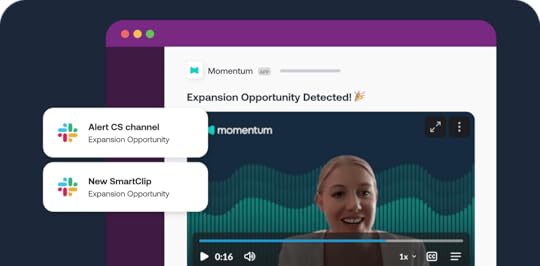 AI GTM - a little bit less conversation, a little more action, please!
AI GTM - a little bit less conversation, a little more action, please!Viral LinkedIn posts of how CEOs are bragging about how they’ve fired 50-90% of their sales, marketing, and support departments and replaced them with AI…
Vs.
“FUD - Fear, Uncertainty, Doubt.” Studies have shown that 95% of AI pilots fail.
Vs.
Consulting firms reporting that 78% of companies are advanced AI users (and selling their transformation services to others).

How to make sense out of all these contradictory statements that are popping out faster than ever? You and I probably agree that AI is here to stay, but my personal experience in GTM is that there is a lot of talk about it, and usually very little to show. And I don’t seem to be the only one thinking so.
Momentum, an AI RevOps orchestration platform, analyzed over 1,000 calls from their prospects (SMBs and enterprises alike) in the last 6 months across 150+ industries. Remember - those companies are EARLY adopters of enterprise AI, not some dinosaurs that are only now catching up with cloud computing. Based on analysis of actual sales conversations (not self-evaluation surveys where everybody wants to look cool), they concluded that:
60% of companies are still doing lots of manual work that could be done with mainstream AI (lagging in adoption of AI based on what technology can do ATM),
29% have started to use AI, but as fragmented projects,
Only 11% have advanced, orchestrated AI implementations that support end-to-end workflows, enabling AI agents to utilize artificial intelligence for decision-making.
More insights from Momentum’s survey on how companies are adopting AI in 2025 will be available in their next report - I’ll share it in GTM Strategist as well.
Fun fact: these days, the final stage is called agentic AI agents :) - because the term AI agents is often used to describe standard automations that can be achieved with tools like Zapier at significantly lower cost - essentially, people building agents for the sake of building agents 🤷 oh, well.
And yeah - that made us think that 90% of AI adoption is fiction.

So if you feel like you’re behind, you kind of are based on what technology can do ATM.
But good news - so is almost everyone else 😅, so let’s catch up really fast.
The challenge isn’t adopting “any AI.”
The challenge lies in adopting AI that delivers tangible benefits and positive ROI to your business.
And I believe the best place to start is by re-visioning workflows in validated GTM Motions (predictable and scalable ways to get customers).
Kyle and I need YOUR Input: GTM Motions & AI adoption - Where are we really at?By now, I do not know a single working person who does not use AI.
Last week, OpenAI & Harvard researchers published a massive study that beautifully illustrated what Ruben Hassid has brilliantly described as
The Big Three use cases of ChatGPT (≈80% of all chats):
Practical Guidance (how-to, tutoring, creative ideation)
Seeking Information (search-like queries)
Writing (drafting + editing).
 Why people are using ChatGPT https://www.nber.org/system/files/working_papers/w34255/w34255.pdf
Why people are using ChatGPT https://www.nber.org/system/files/working_papers/w34255/w34255.pdfEven my 60-year-old mother, who works as a student manager at a university, uses ChatGPT. When she got a new phone, one of the first apps she wanted to transfer was “artificial intelligence,” aka ChatGPT. At that moment, it became crystal clear to me that we have reached an early majority.
As ChatGPT/Claude/your favorite AI model becomes a modern-day browser, personal assistant, confidant, document management system, and editor/proofreader, we have to tackle AI-empowerment of GTM motions a bit differently.
By now, every GTM motion has undergone a significant transformation over the last year and a half, incorporating at least some AI-enabled tools, workflows of even opportunities to implement AI agents and multi-agentic workflows.
While it is more likely that you are getting a message from an AI than a human you don’t know in the outbound arena, where practically all the mainstream vendors have adopted at least some AI capacities and companies are testing 1000s of AI generated or assisted ads creative daily, GTM motions include more human components that are changing at a slightly slower pace - but they are changing.
But I might live in my special AI-loving-bubble 🫧 here, and to be able to serve you more accurately insights into the future - I need your help!
Kyle Poyar and I joined forces to work together on the GTM Motions 2025 Survey.
We are aiming to collect >2000 responses that will get us great insights on:
What is changing and what is not changing in GTM with AI
What is working and what is not
What are the top tools
How are 2026 GTM prospects looking globally?

Please fill in our survey here
So we can prepare a holistic, well-researched report on the topic.
We REALLY need you in our corner for this, so please feel free to share the link to the survey on your social media, newsletters, or directly with your colleagues and other GTM practitioners who are crafting the future of AI GTM.
Huge thanks, friends 🙏
Implementing AI to GTM Motions? Think Workflow first.One of the first GTM motions that I’ve strategically wanted to elevate with AI was Inbound.
 Schema of my Inbound GTM Motion reinvented to be AI-first
Schema of my Inbound GTM Motion reinvented to be AI-firstWhy? Because we spend 30+hours a week there with the team, and it still accounts for 70+% of our pipeline.
So yeah, instead of playing around with “random tools” and vibe-coding “dog name generators”, I wanted to make a measurable impact on a workflow that is already well established and mature in my business.
This was the process I used for elevating my LinkedIn process:
List all the processes, tools, activities, responsibilities, and time spent there
Identify the bottlenecks - where are we spending most time or marginal impact (candidates for automation)
Study where automations will do the job and where are the strategic opportunities for implementing AI - aka agents in the workflow
Redefine the workflow using opportunities to implement AI
Prioritize implementation opportunities based on effort-impact
Make sure you have good data sources - garbage in, garbage exponentially out when it comes to AI
Sharpen the prompting skills of my team and generate hands-on examples of what “great looks like”
Select the tools and do test implementations - we tested 8 tools to select 3 to include in our ongoing processes
Test in control environments to make sure it works
Tweak, scale and present to clients and partners.
All in all, I use 3 custom AI writing assistants, 4 automation custom scripts, a “team” of 7 AI agents + 5 tools to support this process.
After the implementation, we managed to reduce the time spent on our “content and adjacent work” to 17h/week, and the pipeline got “better”.
I will not throw around random numbers like “This is a 2M ARR workflow run by 7 agents”. This is a process that took years to build and perfect. Now it is supported with AI - but it still takes a significant amount of human input and strategic thinking muscles.
I am blessed to work with some of the best companies in my career and fantastic AI-first startups and scaleups with so much potential. I have never been happier with the type of work I do.
Some agents that we benefit the most from:
Research agents - search for best practices of influencers on LinkedIn to create design moodboards and train AI writers
“ICP fit” agent + social selling ideas - helps us extract selling signals from social media posts, analyzes accounts and plans the best way to start the conversation with them
LinkedIn writing coach - that analyzes my results, benchmarks them against best practices and gives me hands-on recommendations on how to improve
But even the best agent breaks down without clear prompts.
Head of GTM at Momentum and self-identified prompting geek, Jonathan “Coach K” Kvarfordt, teaches the GRACE framework:

G – Goal or Role: What outcome do you want? Who should the AI “be” (finance analyst, McKinsey consultant)?
R – Rules: Clear rules and boundaries.
A – Advanced Context: What’s happening in your system/business? The more background context, the better.
C – Clear Instructions: Tell AI what you want in a sequence of steps.
E – Examples: Show what “good” looks like (and what “bad” looks like).
I applied it to my work too, and it works like a charm, especially with GPT-5.
Most failures come from missing context or missing examples.
Get those right, and hallucinations drop dramatically. 👌
Uf - running out of space here and so much more to tell and show you …
How about this:
Join Jonathan and me at the Momentum AI Hub webinar on Oct 8th, 2025, at 12:00 EST.
FREE online and we’ll show you how we do it IRL.
 So, where does our “Carbon Intelligence” fit in this AI-first GTM Motion world
So, where does our “Carbon Intelligence” fit in this AI-first GTM Motion worldAs we discuss the changes in GTM, Jeff Bezos suggests we ask ourselves what will remain unchanged.
Every trend has an anti-trend, and here is my best guess of what that might be for AI-enabled-everything in GTM.
As long as humans continue to interact with one another, trust, intimacy, genuine human connections, empathy, and other “softer skills” will inevitably become more valuable.
The other thing that will not change is stakeholder management 🙂 - as long as humans work with humans, this skill will become more valuable than ever. I like to joke with my teams - no AI is smart or stupid enough to replace stakeholder management.
Last but not least - we humans are the architects of AI workflows and implementations, so even if we enter the “future” where my buying agent will transact with your seller agent without us ever meeting, these agents would be trained on our knowledge assets, so in a way, they would be partially like us.
To keep these conversations more hands-on - utilize AI for what it is excellent at - double down on strategically bridging the gaps where it fails and on what it was not designed to do by default.
As Ben Williams (PLGeek), put it in The New Growth PM Playbook: What AI Can’t Replace:
“AI excels at pattern recognition, synthesis, and suggestion—it can clean data, draft onboarding copy, cluster feedback, and generate test ideas faster than humans ever could. But defining the right problems, making strategic trade-offs, and building trust across teams remain deeply human responsibilities. The edge for growth leaders in an AI-first GTM world is not competing with AI on execution, but doubling down on judgment, influence, storytelling, and empathy. In other words: let AI automate the busywork, so you can focus on the higher-order skills that move markets and build trust.”
But most importantly - run towards your fears.
Learn it. Prototype with it. See if it can help you.
Who knows - maybe you will end up finding a lot of value and have fun with it.
But keep your critical thinking and security awareness intact.
My rule of thumb is: if I wouldn’t send a file to a friend, I won’t upload it to ChatGPT.
What is yours?

📘 New to GTM? Learn fundamentals. Get my best-selling GTM Strategist book that helped 9,500+ companies to go to market with confidence - frameworks and online course included.
✅ Need ready-to-use GTM assets and AI prompts? Get the 100-Step GTM Checklist with proven website templates, sales decks, landing pages, outbound sequences, LinkedIn post frameworks, email sequences, and 20+ workshops you can immediately run with your team.
🏅 Are you in charge of GTM and responsible for leading others? Grab the GTM Masterclass (6 hours of training, end-to-end GTM explained on examples, guided workshops) to get your team up and running in no time.
🤝 Want to work together? ⏩ Check out the options and let me know how we can join forces.
September 19, 2025
What Companies Are Doing TODAY to Rank High on AI Engines
Dear GTM Strategist!
After the unexpected success of the first Generative Engine Optimization (GEO) article that instantly became one of the most popular posts here in 2025, I wanted to double down on what you are apparently interested in.
While we are still figuring out how to call the new SEO in the age of AI…
 https://www.linkedin.com/posts/timsoulo_serious-question-did-we-all-agree-on-the-activity-7371958218161344512-gpvR
https://www.linkedin.com/posts/timsoulo_serious-question-did-we-all-agree-on-the-activity-7371958218161344512-gpvR…some champs in my network managed to unlock a massive new revenue opportunity by being one of the first hits for AI searches in their category.
Today, I share some of their GEO playbooks with you, and I prepared a checklist on how you can elevate your GTM traction and become one of the first companies to unlock this massive opportunity to become “go-to” entities in the era of zero-click customer journeys.
You’ll learn:
How to analyze your brand and how well or poorly competitors are doing on AI engines using Brand Radar 2.0 by Ahrefs
3 case studies of how some AI agent tools became leaders in their category
I’ll share my checklist for GEO optimizations that I use with my clients
This time, no “what is GEO” - fundamentals are well covered here. This time action only, so let’s get tactical! ✌️
Understand the space you compete in: Brand RadarEvery great GTM playbook begins by observing what works well for others, generating intelligence, and then acting based on that insight.
GEO used to be a black box, but new tools are now increasingly enabling visibility into how the answers are shaped in ChatGPT, Google AI Summaries, and other AI chatbots.
I analyzed some of the top AI agents brands in my space to determine which ones index well for GEO, allowing me to reverse-engineer their best practices.
Here is a tl;dr version:

Next, I wanted to dive deeper - what exactly are these companies doing so right?
How did they crush the AI ranks - often against all odds, since some of them are not category leaders and are competing with billion-dollar competitors with massive content, SEO and search budget 🤷
I wanted to learn exactly what they did and how you and I can replicate their success.
How AI search really differs from traditional searchThe biggest mistake I see right now?
Founders assuming their SEO strategy will “just carry over” into AI search.
It won’t.
Here’s why the new rules of the game are so different:
From clicks → to citations
Traditional search engines give you a buffet of links. The game is to win clicks and position as high as possible.
In AI search, there are no blue links to compete for - the prize is to be mentioned directly in the answer. A link is sometimes just a bonus.
From websites → to answers
SEO’s mission has always been: “bring traffic to your website.”
GEO flips that: even if users never land on your domain, you still need to be accurately represented inside the AI-generated answer itself. Yes, due to AI search, website traffic is already falling. Many companies report higher conversion rates from AI traffic - customers arrive at your website better informed, later in their buying journey, because they already did their research elsewhere (in their AI chatbot). That’s why you need to be visible in AI search.
From backlinks → to trust signals everywhere
Google rewards backlinks and domain rank.
AI engines reward breadth and credibility across multiple trusted and credible sources: try to get mentioned on review sites, “best of” lists, community forums like Reddit, expert commentary, and even mentions on social media like LinkedIn. Here is Ahrefs’ analysis of visibility factors.
From short queries → to conversations
On Google, people type 3-4 words.
With ChatGPT or Gemini, users write long, natural-language questions: “What’s the best project management tool for startups under $50/month?”
That shift changes which brands surface - and who gets left invisible.
From index → to synthesis
SEO is about climbing higher in the index of ranked pages.
GEO is about being consistently present in the summaries AI models generate by blending their training data with real-time retrieval (RAG).
SEO was about being discoverable in a list.
GEO is about being the trusted reference inside a single authoritative-sounding answer.
I used Ahrefs Brand Radar 2.0 to research which companies are rocking GEO in their categories and what they are doing.
It’s very simple to use: you enter your brand and your key competitors (example below - it can even suggest more competitors). Market or niche is optional and I prefer to keep a broader research.
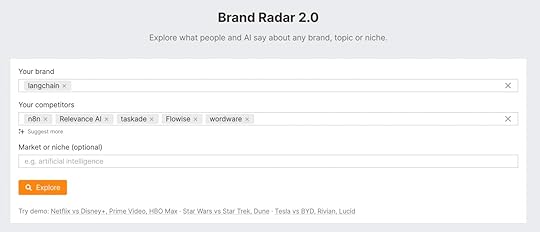 Example of a Brand Radar query
Example of a Brand Radar query
 And this is how the output looks like (we’ll dive into details in a sec)Case 1: AI Agent Builders
And this is how the output looks like (we’ll dive into details in a sec)Case 1: AI Agent Builders

I compared the key players in the field of AI agent builders and I see that LangChain’s AI mentions really skyrocketed from August on.
One of the key resources cited by LLMs is an AWS article that explains what LangChain is. This shows that mentions (well, not just mentions, but deep dive articles) on high authority websites can really move the needle in GEO.
But even n8n, although with more modest growth, can be reverse-engineered to some good practices with Brand Radar. They hold a solid 2nd place in the category, and one of the top-cited resources is a debate in the “Automation” subreddit on Reddit.
Here is how the top-cited domains in GEO for AI agent builders look like:
 Case 2: AI Sales Agents
Case 2: AI Sales Agents

For AI sales agents, Momentum.io is leading the game. In this case, Brand Radar data just confirmed what I was already hearing before from the team: they doubled down on their inbound strategy in the last months and started generating lots of blog posts on different topics connected to actual questions that customers would ask AI chatbots.
These questions differ from googling. Whereas on Google a user would mostly write keywords (e.g. best AI sales tools), on a chatbot, a user would write a specific problem-related question, like: “How can I improve the productivity of my sales team?”
The result: blog posts like this one that are often picked up by LLMs:

Looking at the top-cited domains, we see once again how general high-authority websites like YouTube are driving the mentions, too.
Case 3: AI Marketing Agents
Well, you can be sure that it is a marketing category because there are more competitors trying hard, each with its own good practices.
Copy.ai leads the pack, although Rytr actually has the top-cited page:

A variety of sources still trumps a single well-positioned source.
The mentions are quite consistent across the chatbots:

This means that strategies for optimization are similar.
And as you can see, although we are used to thinking of AI search as ChatGPT, Google is stepping up the game with its AI Overviews, so the majority of AI search is already being transferred to Google.
And this is another case in point that you need to think beyond traditional SEO: because Google itself is drastically changing the way it delivers answers to queries and is shifting to the zero-click strategy as well.
(We’re all still curious how it will impact their Google Ads business model.)
Meanwhile, these are the topics that AI marketing agents are being mentioned on:

Wow! That was interesting.
Now, based on my independent research with Brand Radar, best practices from my colleagues in the network and AI search engine algo studies by Ahrefs - I can give you a long story short version of this research process.
Here is my GEO checklist of what you need to do to get your brand indexed on GEO based on insights that we have in September 2025 for those that might be reading later.
GEO Checklist: What Brands Need to Do to WinIf SEO was about optimizing pages for web crawlers, GEO is about optimizing your entire digital footprint for AI answers.
Here’s the checklist I now use with my clients:
Audit your presence inside AI engines
Run prompt tests in ChatGPT, Gemini, Perplexity, Claude. Track: Is your brand mentioned? Which competitors show up? What sources get cited?
Design a set of prompts to regularly test
Don’t just test “best CRM” - mimic real user behavior: “What’s the best CRM for me as a solopreneur?”
Expand beyond your website
AI models pull from community and third-party sources. Secure mentions in “best of” lists, industry reviews, Reddit, trusted media, and ask well-known partners or customers to publish a post about you (remember the AWS example for LangChain).
Upgrade your authority signals
Publish fact-based, up-to-date, structured content. Make docs, tutorials, and case studies crystal clear so LLMs can cite them with confidence.
Accelerate content velocity
Momentum proved this: publishing 100+ high-quality articles in a single month was enough to dominate their category in AI search. Consistency compounds.
Prioritize low-hanging fruit
Follow Ahrefs’ research: there are still queries with low competition where early movers can claim visibility fast. Don’t start with the hardest prompts.
Track, iterate, repeat
GEO is not “set and forget.” Signals shift faster than Google’s algorithm ever did. Re-run your benchmarks monthly, close visibility gaps, and expand coverage.

Winning GEO isn’t about tricking algorithms.
It’s about becoming so visible, credible, and frequently cited that AI engines can’t ignore you.
How to put GEO in practice: your 7-day and 6-month plansWinning GEO isn’t a one-off campaign.
Here’s an implementation plan you can follow:
In the next 7 days (audit and quick wins)
Run your first benchmark: Test prompts in ChatGPT, Gemini, Perplexity, Claude to check how you score.
Audit your Brand Radar score in Ahrefs (visibility of your brand vs. competitors).
Build a set of prompts - 10–15 queries that include real buyer questions (“What is the best tool for [task]”, What are the best alternatives to [category leader]”...).
Identify your biggest gaps: Which competitors are visible where you’re invisible?
In the next 30 days (building the foundations)
Refresh or publish core content designed to be easily cited: FAQs, tutorials, comparisons, case studies.
Place your brand in third-party ecosystems: “best of” lists, review platforms, forums, expert mentions on social media…
Start building backlinks with context: Guest posts, partnerships, social campaigns that tie back to your category keywords.
Create a visibility tracker: Spreadsheet or Notion board logging prompts, engines, mentions, sources, and competitors.
In the next 3 months (getting the momentum)
Scale your content velocity: At least 2–3 high-quality, relevant pieces per week.
Run monthly benchmarking across your set of prompts to measure improvement.
Analyze citation sources: Which blogs, docs, or community mentions get your competitors cited? Reverse-engineer and replicate.
Experiment with structured content (schemas, metadata, clear headings) to increase LLM interpretability. LLMs work best when content follows structure.
In 6–12 months (durability)
Aim for ecosystem integration: being recommended in educational resources, industry reports, curated libraries, try to secure a mention in high-authority media, or by well-known partners.
Establish canonical authority: whitepapers, industry benchmarks, research-backed content that LLMs will pick up on in the next retraining cycles.
Layer on advanced distribution to target international audience: translations, localization, multimedia content that strengthens your long-term presence across global LLMs.
Your Weekly GEO WorkflowTo stay on top of GEO without burning out, set yourself a reminder to focus on a few small high-impact tasks every week:
Benchmark visibility → Run a quick Brand Radar check + test 2–3 prompts from your set. Check who’s surfacing in AI answers where you’re not and log insights.
Publish or update content → Ship at least one asset (FAQ, tutorial, comparison, case study).
Secure one new mention → Pitch for inclusion in a “best of” list, guest post, or community roundup.
Engage in communities → Answer 2–3 relevant questions on LinkedIn, Reddit, Quora, Stack Overflow, or niche forums.
If you keep this rhythm, your GEO presence compounds week after week.
GEO is still a new field and as you could see, the rankings can change fast. Luckily, this means that we are have a similar starting point with the right strategy.
So just start, explore, experiment, monitor, and let me know what works for you.
Let’s go to the GEO market!

📘 New to GTM? Learn fundamentals. Get my best-selling GTM Strategist book that helped 9,500+ companies to go to market with confidence - frameworks and online course included.
✅ Need ready-to-use GTM assets and AI prompts? Get the 100-Step GTM Checklist with proven website templates, sales decks, landing pages, outbound sequences, LinkedIn post frameworks, email sequences, and 20+ workshops you can immediately run with your team.
🏅 Are you in charge of GTM and responsible for leading others? Grab the GTM Masterclass (6 hours of training, end-to-end GTM explained on examples, guided workshops) to get your team up and running in no time.
🤝 Want to work together? ⏩ Check out the options and let me know how we can join forces.



